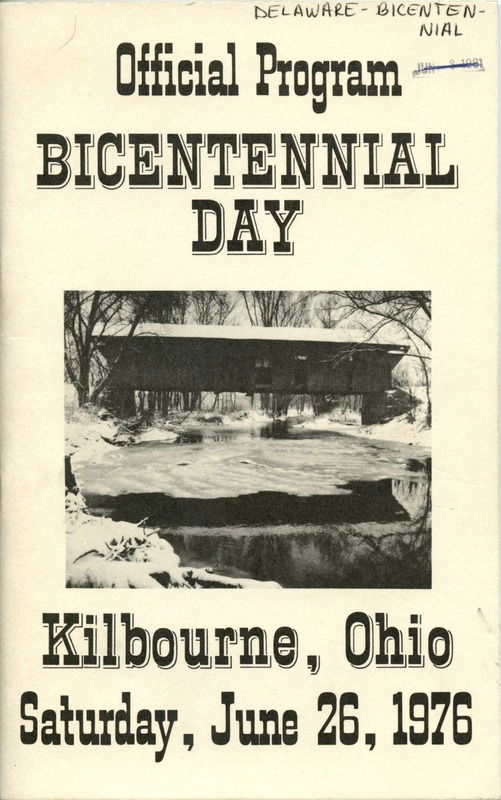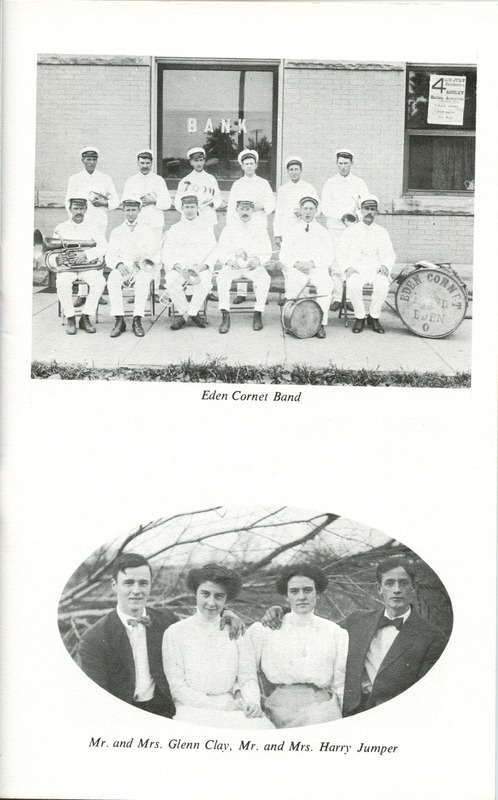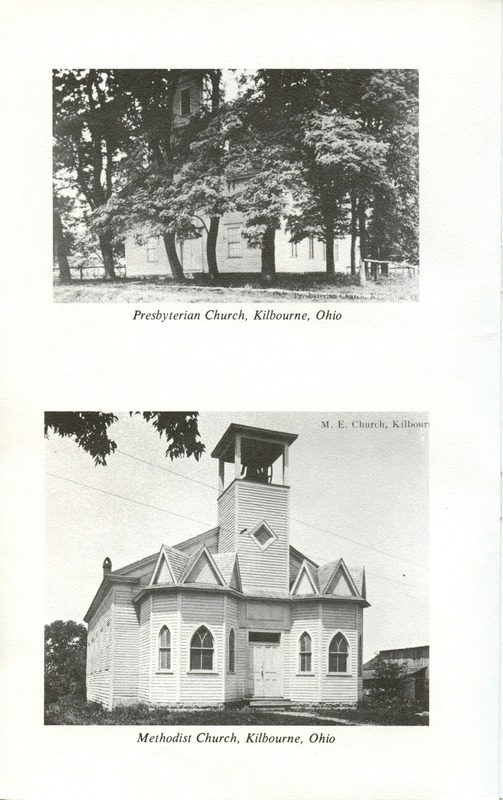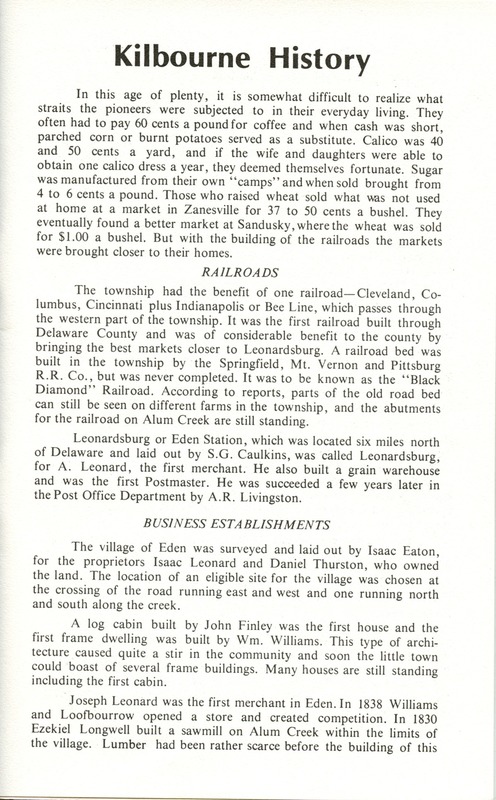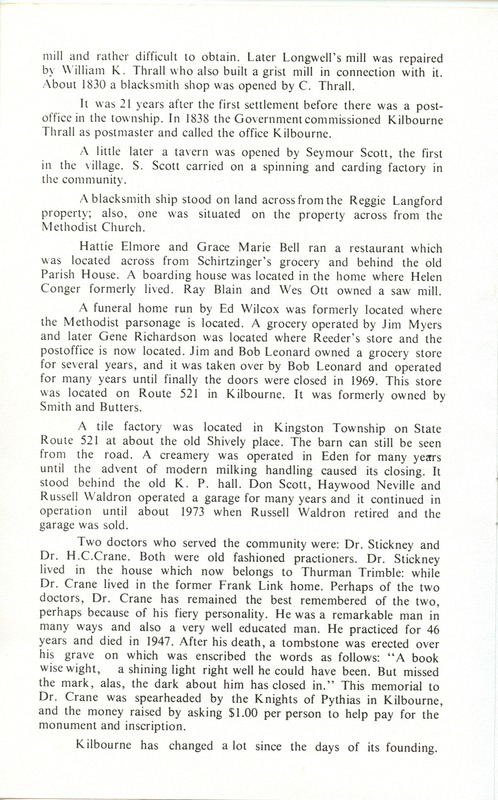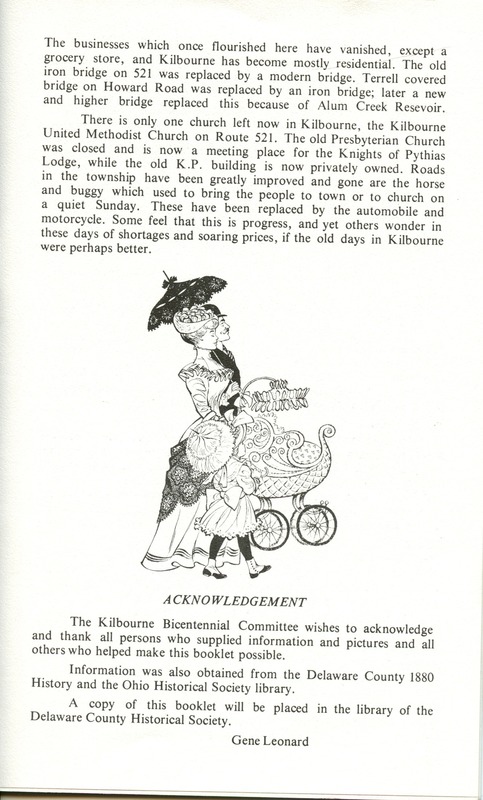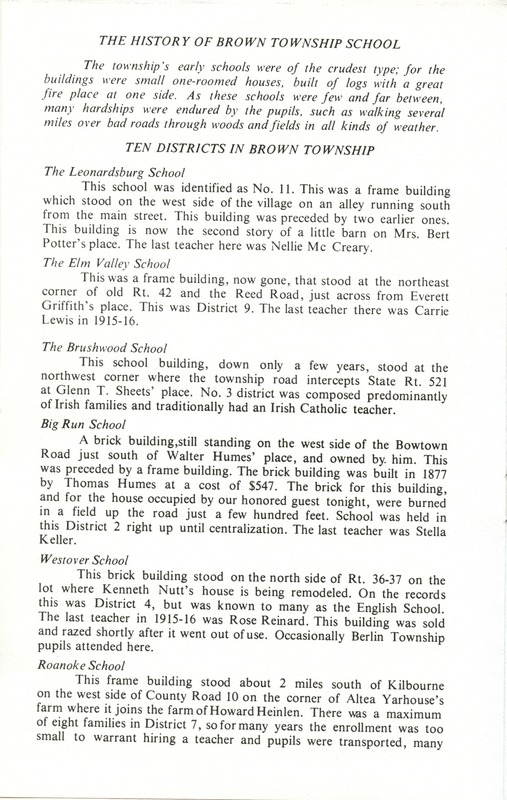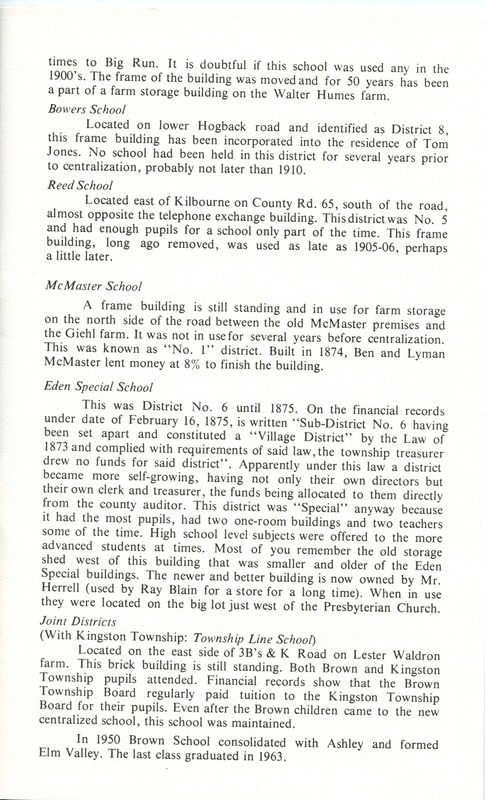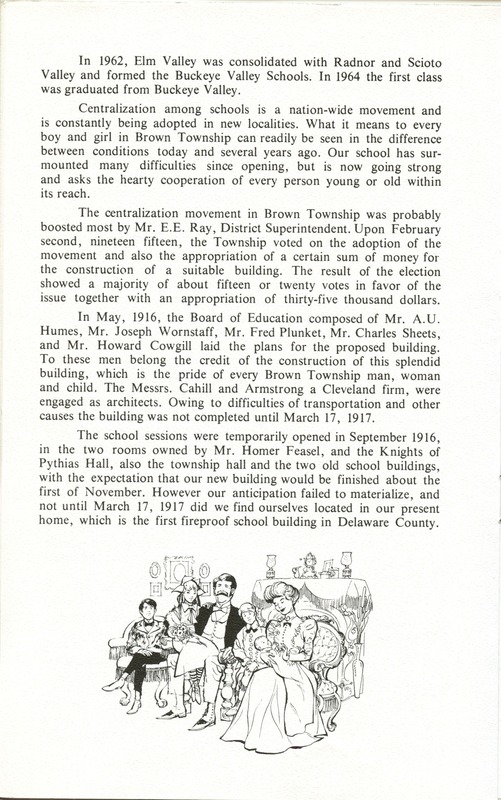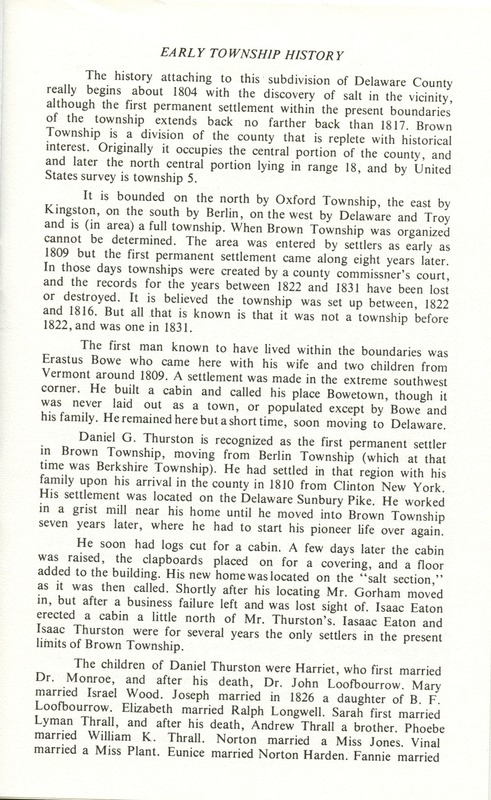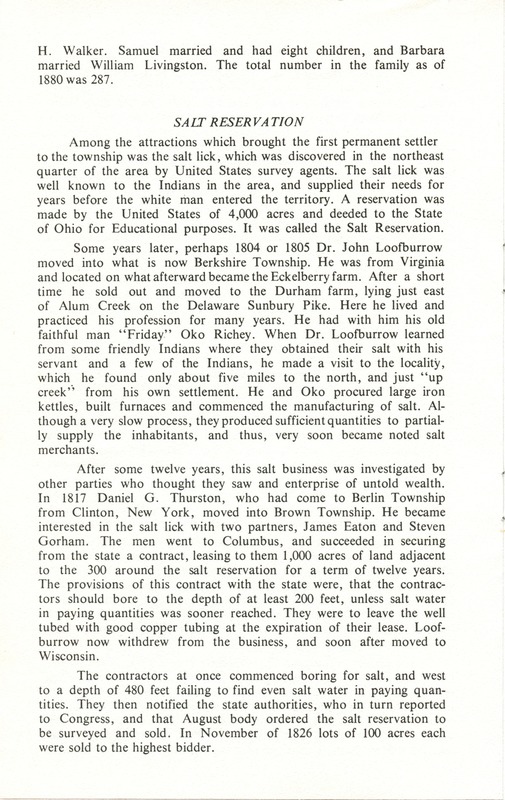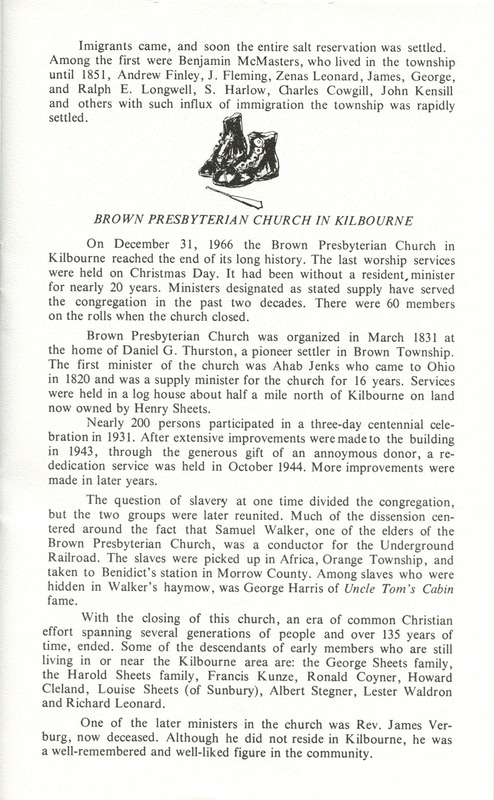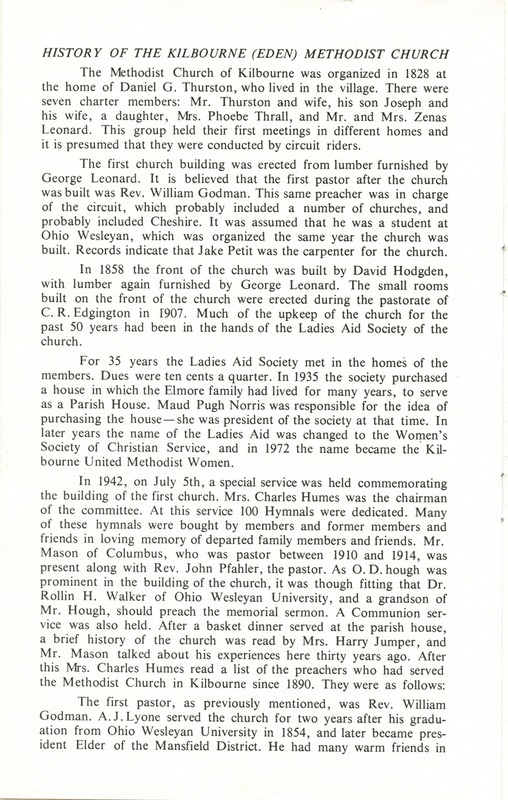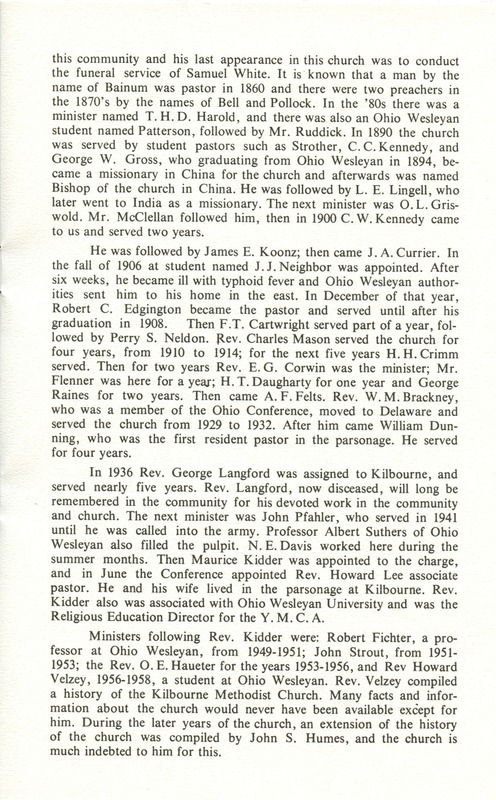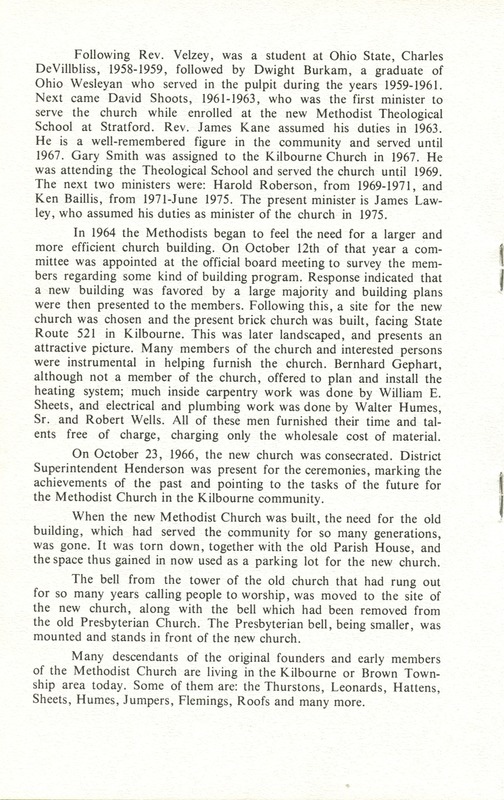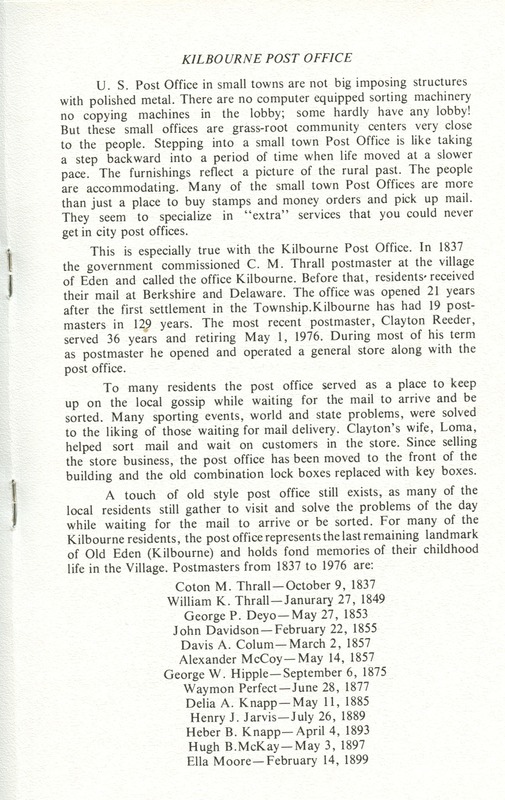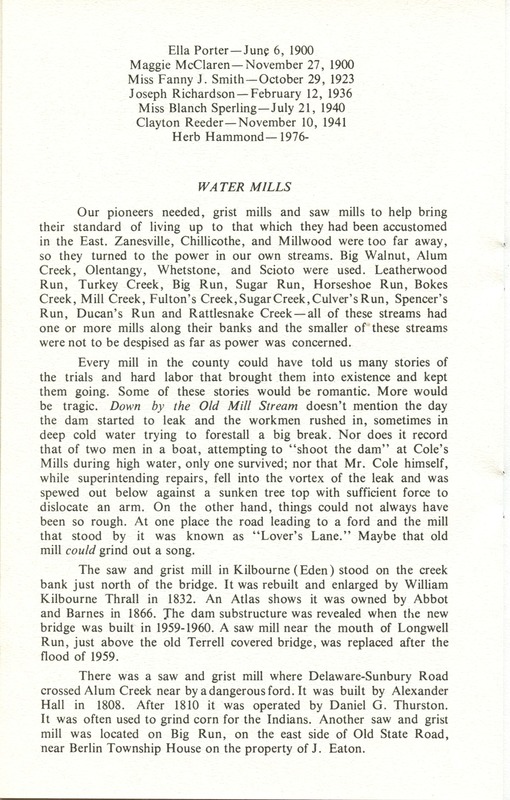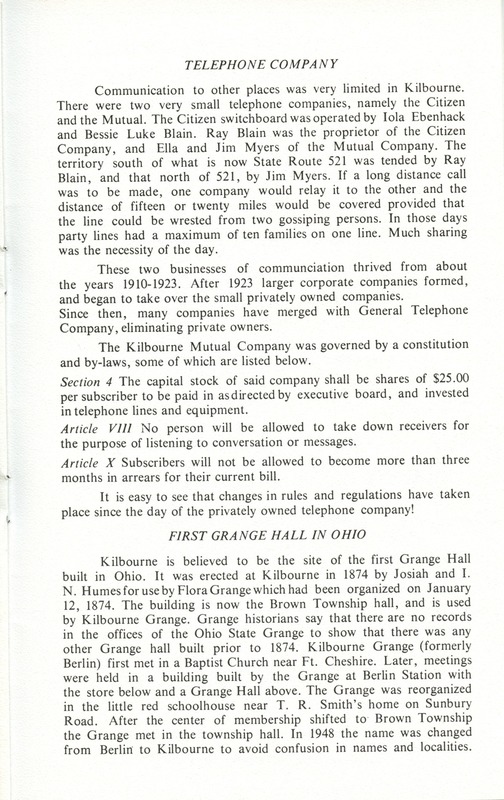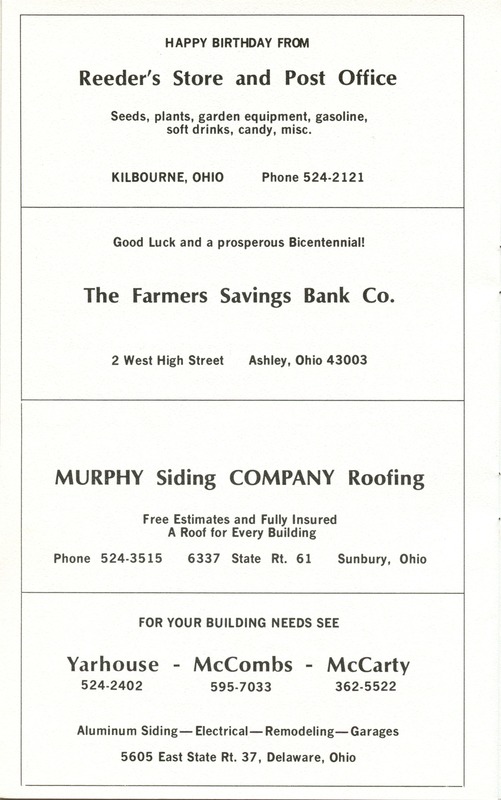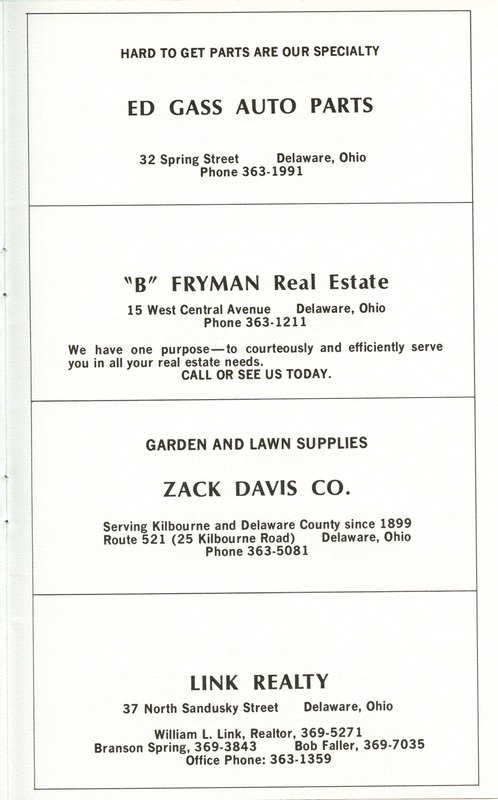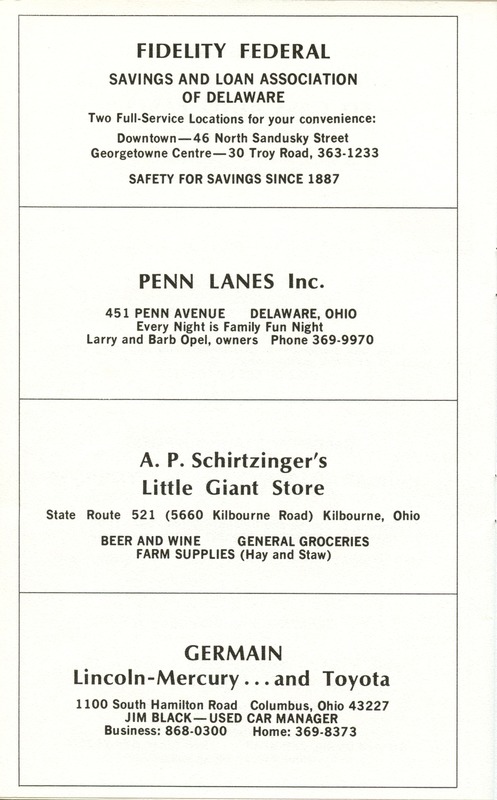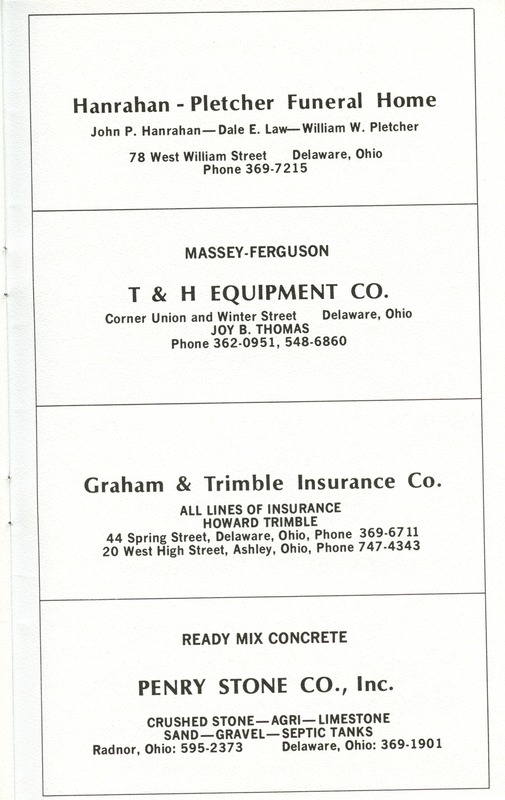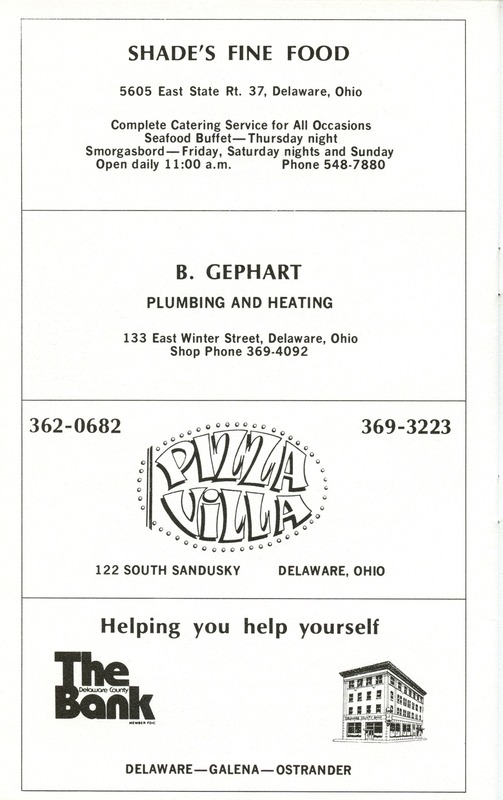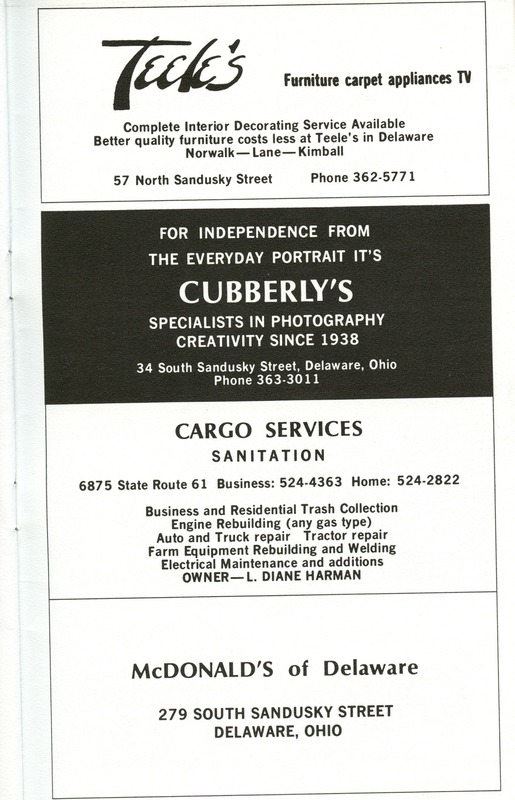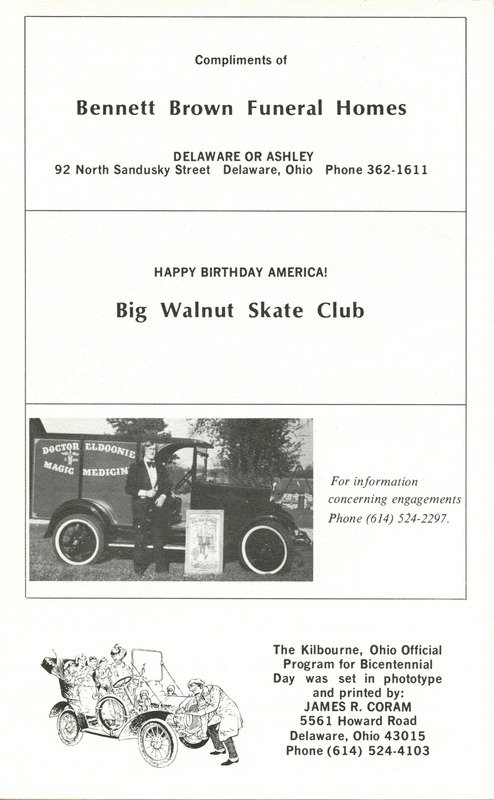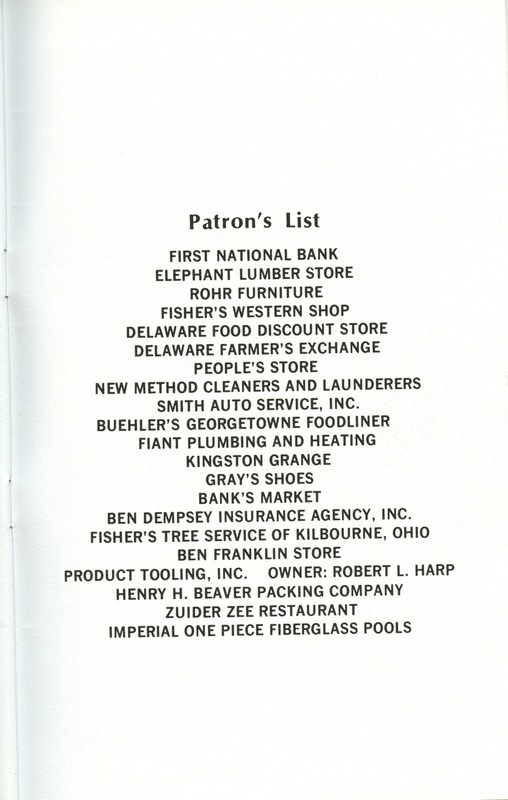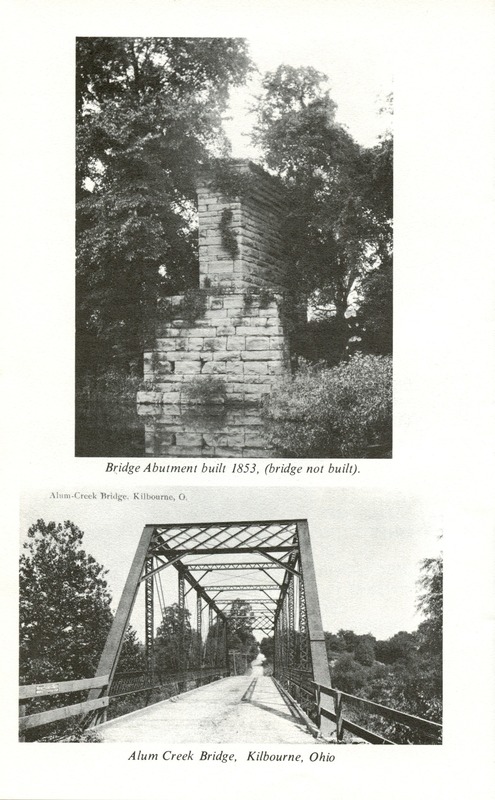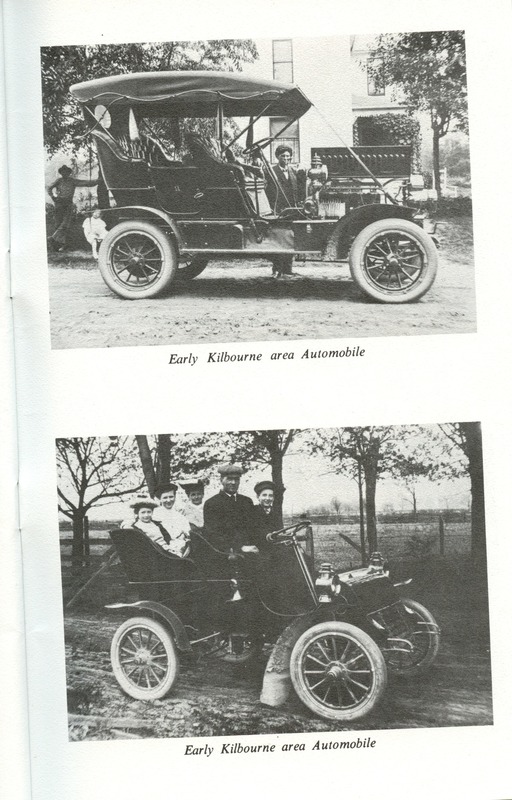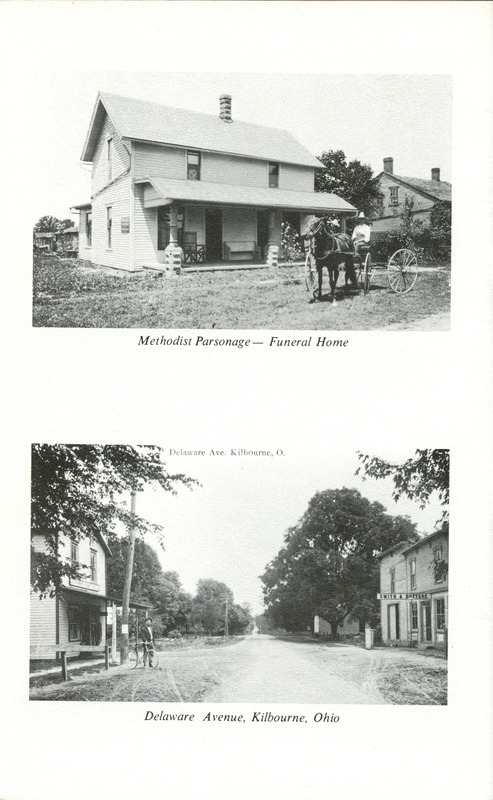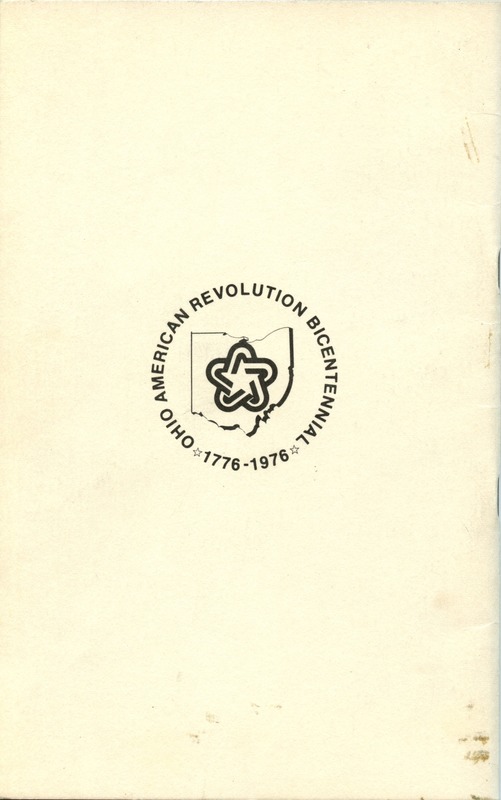Kilbourne Bicentennial Day Program
Title
Kilbourne Bicentennial Day Program (p. 1)
Description
[page 1]
[corresponds to front cover of Kilbourne Bicentennial Day Program]
Official Program
BICENTENNIAL
DAY
[photo]
Kilbourne, Ohio
Saturday, June 26, 1976
[corresponds to front cover of Kilbourne Bicentennial Day Program]
Official Program
BICENTENNIAL
DAY
[photo]
Kilbourne, Ohio
Saturday, June 26, 1976
Title
Kilbourne Bicentennial Day Program (p. 2)
Description
[page 2]
[corresponds to unlabeled page 2 of Kilbourne Bicentennial Day Program]
[photo]
Eden Cornet Band
[photo]
Mr. and Mrs. Glenn Clay, Mr. and Mrs. Harry Jumper
[corresponds to unlabeled page 2 of Kilbourne Bicentennial Day Program]
[photo]
Eden Cornet Band
[photo]
Mr. and Mrs. Glenn Clay, Mr. and Mrs. Harry Jumper
Title
Kilbourne Bicentennial Day Program (p. 3)
Description
[page 3]
[corresponds to unlabeled page 3 of Kilbourne Bicentennial Day Program]
[photo]
Presbyterian Church, Kilbourne, Ohio
[photo]
Methodist Church, Kilbourne, Ohio
[corresponds to unlabeled page 3 of Kilbourne Bicentennial Day Program]
[photo]
Presbyterian Church, Kilbourne, Ohio
[photo]
Methodist Church, Kilbourne, Ohio
Title
Kilbourne Bicentennial Day Program (p. 4)
Description
[page 4]
[corresponds to unlabeled page 4 of Kilbourne Bicentennial Day Program]
Kilbourne History
In this age of plenty, it is somewhat difficult to realize what
straits the pioneers were subjected to in their everyday living. They
often had to pay 60 cents a pound for coffee and when cash was short,
parched corn or burnt potatoes served as a substitute. Calico was 40
and 50 cents a yard, and if the wife and daughters were able to
obtain one calico dress a year, they deemed themselves fortunate. Sugar
was manufactured from their own "camps" and when sold brought from
4 to 6 cents a pound. Those who raised wheat sold what was not used
at home at a market in Zanesville for 37 to 50 cents a bushel. They
eventually found a better market at Sandusky, where the wheat was sold
for $1.00 a bushel. But with the building of the railroads the markets
were brought closer to their homes.
RAILROADS
The township had the benefit of one railroad--Cleveland, Co-
lumbus, Cincinnati plus Indianapolis or Bee Line, which passes through
the western part of the township. It was the first railroad built through
Delaware County and was of considerable benefit to the country by
bringing the best markets closer to Leonardsburg. A railroad bed was
built in the township by the Springfield, Mt. Vernon and Pittsburg
R.R. Co., but was never completed. It was to be known as the "Black
Diamond" Railroad. According to reports, parts of the old road bed
can still be seen on different farms in the township, and the abutments
for the railroad on Alum Creek are still standing.
Leonardsburg or Eden Station, which was located six miles north
of Delaware and laid out by S. G. Caulkins, was called Leonardsburg,
for A. Leonard, the first merchant. He also built a grain warehouse
and was the first Postmaster. He was succeeded a few years later in
the Post Office Department by A. R. Livingston.
BUSINESS ESTABLISHMENTS
The village of Eden was surveyed and land laid out by Isaac Eaton,
for the proprietors Isaac Leonard and Daniel Thurston, who owned
the land. The location of an eligible site for the village was chosen at
the crossing of the road running east and west and one running north
and south along the creek.
A log cabin built by John Finley was the first house and the
first frame dwelling was built by Wm. Williams. This type of archi-
tecture caused quite a stir in the community and soon the little town
could boast of several frame buildings. Many houses are still standing
including the first cabin.
Joseph Leonard was the first merchant in Eden. In 1838 Williams
and Loofbourrow opened a store and created competition. In 1830
Ezekiel Longwell built a sawmill on Alum Creek within the limits of
the village. Lumber had been rather scarce before the building of this
[corresponds to unlabeled page 4 of Kilbourne Bicentennial Day Program]
Kilbourne History
In this age of plenty, it is somewhat difficult to realize what
straits the pioneers were subjected to in their everyday living. They
often had to pay 60 cents a pound for coffee and when cash was short,
parched corn or burnt potatoes served as a substitute. Calico was 40
and 50 cents a yard, and if the wife and daughters were able to
obtain one calico dress a year, they deemed themselves fortunate. Sugar
was manufactured from their own "camps" and when sold brought from
4 to 6 cents a pound. Those who raised wheat sold what was not used
at home at a market in Zanesville for 37 to 50 cents a bushel. They
eventually found a better market at Sandusky, where the wheat was sold
for $1.00 a bushel. But with the building of the railroads the markets
were brought closer to their homes.
RAILROADS
The township had the benefit of one railroad--Cleveland, Co-
lumbus, Cincinnati plus Indianapolis or Bee Line, which passes through
the western part of the township. It was the first railroad built through
Delaware County and was of considerable benefit to the country by
bringing the best markets closer to Leonardsburg. A railroad bed was
built in the township by the Springfield, Mt. Vernon and Pittsburg
R.R. Co., but was never completed. It was to be known as the "Black
Diamond" Railroad. According to reports, parts of the old road bed
can still be seen on different farms in the township, and the abutments
for the railroad on Alum Creek are still standing.
Leonardsburg or Eden Station, which was located six miles north
of Delaware and laid out by S. G. Caulkins, was called Leonardsburg,
for A. Leonard, the first merchant. He also built a grain warehouse
and was the first Postmaster. He was succeeded a few years later in
the Post Office Department by A. R. Livingston.
BUSINESS ESTABLISHMENTS
The village of Eden was surveyed and land laid out by Isaac Eaton,
for the proprietors Isaac Leonard and Daniel Thurston, who owned
the land. The location of an eligible site for the village was chosen at
the crossing of the road running east and west and one running north
and south along the creek.
A log cabin built by John Finley was the first house and the
first frame dwelling was built by Wm. Williams. This type of archi-
tecture caused quite a stir in the community and soon the little town
could boast of several frame buildings. Many houses are still standing
including the first cabin.
Joseph Leonard was the first merchant in Eden. In 1838 Williams
and Loofbourrow opened a store and created competition. In 1830
Ezekiel Longwell built a sawmill on Alum Creek within the limits of
the village. Lumber had been rather scarce before the building of this
Title
Kilbourne Bicentennial Day Program (p. 5)
Description
[page 5]
[corresponds to unlabeled page 5 of Kilbourne Bicentennial Day Program]
mill and rather difficult to obtain. Later Longwell's mill was repaired
by William K. Thrall who also built a grist mill in connection with it.
About 1830 a blacksmith shop was opened by C. Thrall.
It was 21 years after the first settlement before there was a post-
office in the township. In 1838 the Government commissioned Kilbourne
Thrall as postmaster and called the office Kilbourne.
A little later a tavern was opened by Seymour Scott, the first
in the village. S. Scott carried on a spinning and carding factory in
the community.
A blacksmith ship stood on land across from the Reggie Langford
property; also, one was situated on the property across from the
Methodist Church.
Hattie Elmore and Grace Marie Bell ran a restaurant which
was located across from Schirtzinger's grocery and behind the old
Parish House. A boarding house was located in the home where Helen
Conger formerly lived. Ray Blain and Wes Ott owned a saw mill.
A funeral home run by Ed Wilcox was formerly located where
the Methodist parsonage is located. A grocery operated by Jim Myers
and later Gene Richardson was located where Reeder's store and the
postoffice is now located. Jim and Bob Leonard owned a grocery store
for several years, and it was taken over by Bob Leonard and operated
for many years until finally the doors were closed in 1969. This store
was located on Route 521 in Kilbourne. It was formerly owned by
Smith and Butters.
A tile factory was located in Kingston Township on State
Route 521 at about the old Shively place. The barn can still be seen
from the road. A creamery was operated in Eden for many years
until the advent of modern milking handling caused its closing. It
stood behind the old K. P. hall. Don Scott, Haywood Neville and
Russell Waldron operated a garage for many years and it continued in
operation until about 1973 when Russell Waldron retired and the
garage was sold.
Two doctors who served the community were: Dr. Stickney and
Dr. H.C.Crane. Both were old fashioned practitioners. Dr. Stickney
lived in the house which now belonds to Thurman Trimble: while
Dr. Crane lived in the former Frank Link home. Perhaps of the two
doctors, Dr. Crane has remained the best remembered of the two,
perhaps because of his fiery personality. He was a remarkable man in
many ways and also a very well educated man. He practiced for 46
years and died in 1947. After his death, a tombstone was erected over
his grave on which was enscribed the words as follows: "A book
wise wight, a shining light right well he could have been. But missed
the mark, alas, the dark about him has closed in." This memorial to
Dr. Crane was spearheaded by the Knights of Pythias in Kilbourne,
and the money raised by asking $1.00 per person to help pay for the
monument and inscription.
Kilbourne has changed a lot since the days of its founding.
[corresponds to unlabeled page 5 of Kilbourne Bicentennial Day Program]
mill and rather difficult to obtain. Later Longwell's mill was repaired
by William K. Thrall who also built a grist mill in connection with it.
About 1830 a blacksmith shop was opened by C. Thrall.
It was 21 years after the first settlement before there was a post-
office in the township. In 1838 the Government commissioned Kilbourne
Thrall as postmaster and called the office Kilbourne.
A little later a tavern was opened by Seymour Scott, the first
in the village. S. Scott carried on a spinning and carding factory in
the community.
A blacksmith ship stood on land across from the Reggie Langford
property; also, one was situated on the property across from the
Methodist Church.
Hattie Elmore and Grace Marie Bell ran a restaurant which
was located across from Schirtzinger's grocery and behind the old
Parish House. A boarding house was located in the home where Helen
Conger formerly lived. Ray Blain and Wes Ott owned a saw mill.
A funeral home run by Ed Wilcox was formerly located where
the Methodist parsonage is located. A grocery operated by Jim Myers
and later Gene Richardson was located where Reeder's store and the
postoffice is now located. Jim and Bob Leonard owned a grocery store
for several years, and it was taken over by Bob Leonard and operated
for many years until finally the doors were closed in 1969. This store
was located on Route 521 in Kilbourne. It was formerly owned by
Smith and Butters.
A tile factory was located in Kingston Township on State
Route 521 at about the old Shively place. The barn can still be seen
from the road. A creamery was operated in Eden for many years
until the advent of modern milking handling caused its closing. It
stood behind the old K. P. hall. Don Scott, Haywood Neville and
Russell Waldron operated a garage for many years and it continued in
operation until about 1973 when Russell Waldron retired and the
garage was sold.
Two doctors who served the community were: Dr. Stickney and
Dr. H.C.Crane. Both were old fashioned practitioners. Dr. Stickney
lived in the house which now belonds to Thurman Trimble: while
Dr. Crane lived in the former Frank Link home. Perhaps of the two
doctors, Dr. Crane has remained the best remembered of the two,
perhaps because of his fiery personality. He was a remarkable man in
many ways and also a very well educated man. He practiced for 46
years and died in 1947. After his death, a tombstone was erected over
his grave on which was enscribed the words as follows: "A book
wise wight, a shining light right well he could have been. But missed
the mark, alas, the dark about him has closed in." This memorial to
Dr. Crane was spearheaded by the Knights of Pythias in Kilbourne,
and the money raised by asking $1.00 per person to help pay for the
monument and inscription.
Kilbourne has changed a lot since the days of its founding.
Title
Kilbourne Bicentennial Day Program (p. 6)
Description
[page 6]
[corresponds to unlabeled page 6 of Kilbourne Bicentennial Day Program]
The businesses which once flourished here have vanished, except a
grocery store, and Kilbourne has become mostly residential. The old
iron bridge on Howard Road was replaced by an iron bridge; later a new
and higher bridge replaced this because of Alum Creek Resevoir.
There is only one church left now in Kilbourne, the Kilbourne
United Methodist Church on Route 521. The old Presbyterian Church
was closed and is now a meeting place for the Knights of Pythias
Lodge, while the old K. P. Building is now privately owned. Roads
in the township have been greatly improved and gone are the horse
and buggy which used to bring the people to town or to church on
a quiet Sunday. These have been replaced by the automobile and
motorcycle. Some feel that this is progress, and yet others wonder in
these days of shortages and soaring prices, if the old days in Kilbourne
were perhaps better.
[image]
ACKNOWLEDGEMENT
The Kilbourne Bicentennial Committee wishes to acknowledge
and thank all persons who supplied information and pictures and all
others who helped make this booklet possible.
Information was also obtained from the Delaware County 1880
History and the Ohio Historical Society library.
A copy of this booklet will be placed in the library of the
Delaware County Historical Society.
Gene Leonard
[corresponds to unlabeled page 6 of Kilbourne Bicentennial Day Program]
The businesses which once flourished here have vanished, except a
grocery store, and Kilbourne has become mostly residential. The old
iron bridge on Howard Road was replaced by an iron bridge; later a new
and higher bridge replaced this because of Alum Creek Resevoir.
There is only one church left now in Kilbourne, the Kilbourne
United Methodist Church on Route 521. The old Presbyterian Church
was closed and is now a meeting place for the Knights of Pythias
Lodge, while the old K. P. Building is now privately owned. Roads
in the township have been greatly improved and gone are the horse
and buggy which used to bring the people to town or to church on
a quiet Sunday. These have been replaced by the automobile and
motorcycle. Some feel that this is progress, and yet others wonder in
these days of shortages and soaring prices, if the old days in Kilbourne
were perhaps better.
[image]
ACKNOWLEDGEMENT
The Kilbourne Bicentennial Committee wishes to acknowledge
and thank all persons who supplied information and pictures and all
others who helped make this booklet possible.
Information was also obtained from the Delaware County 1880
History and the Ohio Historical Society library.
A copy of this booklet will be placed in the library of the
Delaware County Historical Society.
Gene Leonard
Title
Kilbourne Bicentennial Day Program (p. 7)
Description
[page 7]
[corresponds to unlabeled page 7 of Kilbourne Bicentennial Day Program]
THE HISTORY OF BROWN TOWNSHIP SCHOOL
The township's early schools were of the crudest type; for the
buildings were small one-roomed houses, built of logs with a great
fire place at one side. As these schools were few and far between,
many hardships were endured by the pupils, such as walking several
miles over bad roads through woods and fields in all kinds of weather.
TEN DISTRICTS IN BROWN TOWNSHIP
The Leonardsburg School
This school was identified as No. 11. This was a frame building
which stood on the west side of the village on an alley running south
from the main street. This building was preceded by two earlier ones.
This building is now the second story of a little barn on Mrs. Bert
Potter's place. The last teacher here was Nellie Mc Creary.
The Elm Valley School
This was a frame building, now gone, that stood at the northeast
corner of old Rt. 42 and the Reed Road, just across from Everett
Griffith's place. This was District 9. The last teacher there was Carrie
Lewis in 1915-16.
The Brushwood School
This school building, down only a few years, stood at the
northwest corner where the township road intercepts State Rt. 521
at Glenn T. Sheets' place. No. 3 district was composed predominently
of Irish families and traditionally had an Irish Catholic teacher.
Big Run School
A brick building,still standing on the west side of the Bowtown
Road just south of Walter Humes' place, and owned by him. This
was preceded by a frame building. The brick building was built in 1877
by Thomas Humes at a cost of $547. The brick for this building,
and for the house occupied by our honored guest tonight, were burned
in a field up the road just a few hundred feet. School was held in
this District 2 right up until centralization. The last teacher was Stella
Keller.
Westover School
This brick building stood on the north side of Rt. 36-37 on the
lot where Kenneth Nutt's house is being remodeled. On the records
this was District 4, but was known to many as the English School.
The last teacher in 1915-16 was Rose Reinard. This building was sold
and razed shortly after it went out of use. Occassionally Berlin Township
pupils attended here.
Roanoke School
This frame building stood about 2 miles south of Kilbourne
on the west side of County Road 10 on the corner of Altea Yarhouse's
farm where it joins the farm of Howard Heinlen. There was a maximum
of eight families in District 7, so for many years the enrollment was too
small to warrant hiring a teacher and pupils were transported, many
[corresponds to unlabeled page 7 of Kilbourne Bicentennial Day Program]
THE HISTORY OF BROWN TOWNSHIP SCHOOL
The township's early schools were of the crudest type; for the
buildings were small one-roomed houses, built of logs with a great
fire place at one side. As these schools were few and far between,
many hardships were endured by the pupils, such as walking several
miles over bad roads through woods and fields in all kinds of weather.
TEN DISTRICTS IN BROWN TOWNSHIP
The Leonardsburg School
This school was identified as No. 11. This was a frame building
which stood on the west side of the village on an alley running south
from the main street. This building was preceded by two earlier ones.
This building is now the second story of a little barn on Mrs. Bert
Potter's place. The last teacher here was Nellie Mc Creary.
The Elm Valley School
This was a frame building, now gone, that stood at the northeast
corner of old Rt. 42 and the Reed Road, just across from Everett
Griffith's place. This was District 9. The last teacher there was Carrie
Lewis in 1915-16.
The Brushwood School
This school building, down only a few years, stood at the
northwest corner where the township road intercepts State Rt. 521
at Glenn T. Sheets' place. No. 3 district was composed predominently
of Irish families and traditionally had an Irish Catholic teacher.
Big Run School
A brick building,still standing on the west side of the Bowtown
Road just south of Walter Humes' place, and owned by him. This
was preceded by a frame building. The brick building was built in 1877
by Thomas Humes at a cost of $547. The brick for this building,
and for the house occupied by our honored guest tonight, were burned
in a field up the road just a few hundred feet. School was held in
this District 2 right up until centralization. The last teacher was Stella
Keller.
Westover School
This brick building stood on the north side of Rt. 36-37 on the
lot where Kenneth Nutt's house is being remodeled. On the records
this was District 4, but was known to many as the English School.
The last teacher in 1915-16 was Rose Reinard. This building was sold
and razed shortly after it went out of use. Occassionally Berlin Township
pupils attended here.
Roanoke School
This frame building stood about 2 miles south of Kilbourne
on the west side of County Road 10 on the corner of Altea Yarhouse's
farm where it joins the farm of Howard Heinlen. There was a maximum
of eight families in District 7, so for many years the enrollment was too
small to warrant hiring a teacher and pupils were transported, many
Title
Kilbourne Bicentennial Day Program (p. 8)
Description
[page 8]
[corresponds to unlabeled page 8 of Kilbourne Bicentennial Day Program]
times to Big Run. It is doubtful if this school was used any in the
1900's. The frame of the building was moved and for 50 years has been
a part of a farm storage building on the Walter Humes farm.
Bowers School
Located on lower Hogback road and identified as District 8,
this frame building has been incorporated into the residence of Tom
Jones. No school had been held in this district for several years prior
to centralization, probably not later than 1910.
Reed School
Located east of Kilbourne on County Rd. 65, south of the road,
almost opposite the telephone exchange building. This district was No. 5
and had enough pupils for a school only part of the time. This frame
building, long ago removed, was used as late as 1905-06, perhaps
a little later.
McMaster School
A frame building is still standing and in use for farm storage
on the north side of the road between the old McMaster premises and
the Giehl farm. It was not in use for several years before centralization.
This was known as "No. 1" district. Built in 1874, Ben and Lyman
McMaster lent money at 8% to finish the building.
Eden Special School
This was District No. 6 until 1875. On the financial records
under date of February 16, 1875, is written "Sub-District No. 6 having
been set apart and constituted a "Village District" by the Law of
1873 and complied with requirements of said law, the township treasurer
drew no funds for said district". Apparently under this law a district
became more self-growing, having not only their own directors but
their own clerk and treasurer, the funds being allocated to them directly
from the county auditor. This district was "Special" anyway because
it had the most pupils, had two one-room buildings and two teachers
some of the time. High school level subjects were offered to the more
advanced students at times. Most of you remember the old storage
shed west of this building that was smaller and older of the Eden
Special buildings. The newer and better building is now owned by Mr.
Herrell (used by Ray Blain for a store for a long time). When in use
they were located on the big lot just west of the Presbyterian Church.
Joint Districts
(White Kingston Township: Township Line School)
Located on the east side of 3B's & K Road on Lester Waldron
farm. This brick building is still standing. Both Brown and Kingston
Township pupils attended. Financial records show that the Brown
Township Board regularly paid tuition to the Kingston Township
Board for their pupils. Even after the Brown children came to the new
centralized school, this school was maintained.
In 1950 Brown School consolidated with Ashley and formed
Elm Valley. The last class graduated in 1963.
[corresponds to unlabeled page 8 of Kilbourne Bicentennial Day Program]
times to Big Run. It is doubtful if this school was used any in the
1900's. The frame of the building was moved and for 50 years has been
a part of a farm storage building on the Walter Humes farm.
Bowers School
Located on lower Hogback road and identified as District 8,
this frame building has been incorporated into the residence of Tom
Jones. No school had been held in this district for several years prior
to centralization, probably not later than 1910.
Reed School
Located east of Kilbourne on County Rd. 65, south of the road,
almost opposite the telephone exchange building. This district was No. 5
and had enough pupils for a school only part of the time. This frame
building, long ago removed, was used as late as 1905-06, perhaps
a little later.
McMaster School
A frame building is still standing and in use for farm storage
on the north side of the road between the old McMaster premises and
the Giehl farm. It was not in use for several years before centralization.
This was known as "No. 1" district. Built in 1874, Ben and Lyman
McMaster lent money at 8% to finish the building.
Eden Special School
This was District No. 6 until 1875. On the financial records
under date of February 16, 1875, is written "Sub-District No. 6 having
been set apart and constituted a "Village District" by the Law of
1873 and complied with requirements of said law, the township treasurer
drew no funds for said district". Apparently under this law a district
became more self-growing, having not only their own directors but
their own clerk and treasurer, the funds being allocated to them directly
from the county auditor. This district was "Special" anyway because
it had the most pupils, had two one-room buildings and two teachers
some of the time. High school level subjects were offered to the more
advanced students at times. Most of you remember the old storage
shed west of this building that was smaller and older of the Eden
Special buildings. The newer and better building is now owned by Mr.
Herrell (used by Ray Blain for a store for a long time). When in use
they were located on the big lot just west of the Presbyterian Church.
Joint Districts
(White Kingston Township: Township Line School)
Located on the east side of 3B's & K Road on Lester Waldron
farm. This brick building is still standing. Both Brown and Kingston
Township pupils attended. Financial records show that the Brown
Township Board regularly paid tuition to the Kingston Township
Board for their pupils. Even after the Brown children came to the new
centralized school, this school was maintained.
In 1950 Brown School consolidated with Ashley and formed
Elm Valley. The last class graduated in 1963.
Title
Kilbourne Bicentennial Day Program (p. 9)
Description
[page 9]
[corresponds to unlabeled page 9 of Kilbourne Bicentennial Day Program]
In 1962, Elm Valley was consolidated with Radnor and Scioto
Valley and formed the Buckeye Valley Schools. In 1964 the first class
was graduated from Buckeye Valley.
Centralization among schools is a nation-wide movement and
is constantly being adopted in new localities. What it means to every
boy and girl in Brown Township can readily be seen in the difference
between conditions today and several years ago. Our school has sur-
mounted many difficulties since opening, but is now going strong
and asks the hearty cooperation of every person young or old within
its reach.
The centralization movement in Brown Township was probably
boosted most by Mr. E. E. Ray, District Superintendent. Upon February
second, ninteen fifteen, the Township voted on the adoption of the
movement and also the appropriation of a certain sum of money for
the construction of a suitable building. The result of the election
showed a majority of about fifteen or twenty votes in favor of the
issue together with an appropriation of thirty-five thousand dollars.
In May, 1916, the Board of Education composed of Mr. A. U.
Humes, Mr. Joseph Wornstaff, Mr. Fred Plunket, Mr. Charles Sheets,
and Mr. Howard Cowgill laid the plans for the proposed building.
To these men belong the credit of the construction of this splendid
building, which is the pride of every Brown Township man, woman
and child. The Messrs. Cahill and Armstrong a Cleveland firm, were
engaged as architects. Owing to difficulties of transportation and other
causes the building was not completed until March 17, 1917.
The school sessions were temporarily opened in September 1916,
in the two rooms owned by Mr. Homer Feasel, and the Knights of
Pythias Hall, also the township hall and the two old school buildings,
with the expectation that our new building would be finished about the
first of November. However our anticipation failed to materialize, and
not until March 17, 1917 did we find ourselves located in our present
home, which is the first fireproof school building in Delaware County.
[image of family]
[corresponds to unlabeled page 9 of Kilbourne Bicentennial Day Program]
In 1962, Elm Valley was consolidated with Radnor and Scioto
Valley and formed the Buckeye Valley Schools. In 1964 the first class
was graduated from Buckeye Valley.
Centralization among schools is a nation-wide movement and
is constantly being adopted in new localities. What it means to every
boy and girl in Brown Township can readily be seen in the difference
between conditions today and several years ago. Our school has sur-
mounted many difficulties since opening, but is now going strong
and asks the hearty cooperation of every person young or old within
its reach.
The centralization movement in Brown Township was probably
boosted most by Mr. E. E. Ray, District Superintendent. Upon February
second, ninteen fifteen, the Township voted on the adoption of the
movement and also the appropriation of a certain sum of money for
the construction of a suitable building. The result of the election
showed a majority of about fifteen or twenty votes in favor of the
issue together with an appropriation of thirty-five thousand dollars.
In May, 1916, the Board of Education composed of Mr. A. U.
Humes, Mr. Joseph Wornstaff, Mr. Fred Plunket, Mr. Charles Sheets,
and Mr. Howard Cowgill laid the plans for the proposed building.
To these men belong the credit of the construction of this splendid
building, which is the pride of every Brown Township man, woman
and child. The Messrs. Cahill and Armstrong a Cleveland firm, were
engaged as architects. Owing to difficulties of transportation and other
causes the building was not completed until March 17, 1917.
The school sessions were temporarily opened in September 1916,
in the two rooms owned by Mr. Homer Feasel, and the Knights of
Pythias Hall, also the township hall and the two old school buildings,
with the expectation that our new building would be finished about the
first of November. However our anticipation failed to materialize, and
not until March 17, 1917 did we find ourselves located in our present
home, which is the first fireproof school building in Delaware County.
[image of family]
Title
Kilbourne Bicentennial Day Program (p. 10)
Description
EARLY TOWNSHIP HISTORY
The history attaching to this subdivision of Delaware County
really begins about 1804 with the discovery of salt in the vicinity,
although the first permanent settlement within the present boundaries
of the township extends back no farther back than 1817. Brown
Township is a division of the county that is replete with historical
interest. Originally it occupies the central portion of the county, and
and later the north central portion lying in range 18, and by United
States survey is township 5.
It is bounded on the north by Oxford Township, the east by
Kingston, on the south by Berlin, on the west by Delaware and Troy
and is (in area) a full township. When Brown Township was organized
cannot be determined. The area was entered by settlers as early as
1809 but the first permanent settlement came along eight years later.
In those days townships were created by a county commissioner's court,
and the records for the years between 1822 and 1831 have been lost
or destroyed. It is believed the township was set up between, 1822
and 1816. But all that is known is that it was not a township before
1822, and was one in 1831.
The first man known to have lived within the boundaries was
Erastus Bowe who came here with his wife and two children from
Vermont around 1809. A settlement was made in the extreme southwest
corner. He built a cabin and called his place Bowetown, though it
was never laid out as a town, or populated except by Bowe and
his family. He remained here but a short time, soon moving to Delaware.
Daniel G. Thurston is recognized as the first permanent settler
in Brown Township, moving from Berlin Township (which at that
time was Berkshire Township). He had settled in that region with his
family upon his arrival in the county in 1810 from Clinton New York.
His settlement was located on the Delaware Sunbury Pike. He worked
in a grist mill near his home until he moved into Brown Township
seven years later, where he had to start his pioneer life over again.
He soon had logs cut for a cabin. A few days later the cabin
was raised, the clapboards placed on for a covering, and a floor
added to the building. His new home was located on the "salt section,"
as it was then called. Shortly after his locating Mr. Gorham moved
in, but after a business failure left and was lost sight of. Isaac Eaton
erected a cabin a little north of Mr. Thurston's. Iasaac Eaton and
Isaac Thurston were for several years the only settlers in the present
limits of Brown Township.
The children of Daniel Thurston were Harriet, who first married
Dr. Monroe, and after his death, Dr. John Loofbourrow. Mary
married Israel Wood. Joseph married in 1826 a daughter of B. F.
Loofbourrow. Elizabeth married Ralph Longwell. Sarah first married
Lyman Thrall, and after his death, Andrew Thrall a brother. Phoebe
married William K. Thrall. Norton married a Miss Jones. Vinal
married a Miss Plant. Eunice married Norton Harden. Fannie married
The history attaching to this subdivision of Delaware County
really begins about 1804 with the discovery of salt in the vicinity,
although the first permanent settlement within the present boundaries
of the township extends back no farther back than 1817. Brown
Township is a division of the county that is replete with historical
interest. Originally it occupies the central portion of the county, and
and later the north central portion lying in range 18, and by United
States survey is township 5.
It is bounded on the north by Oxford Township, the east by
Kingston, on the south by Berlin, on the west by Delaware and Troy
and is (in area) a full township. When Brown Township was organized
cannot be determined. The area was entered by settlers as early as
1809 but the first permanent settlement came along eight years later.
In those days townships were created by a county commissioner's court,
and the records for the years between 1822 and 1831 have been lost
or destroyed. It is believed the township was set up between, 1822
and 1816. But all that is known is that it was not a township before
1822, and was one in 1831.
The first man known to have lived within the boundaries was
Erastus Bowe who came here with his wife and two children from
Vermont around 1809. A settlement was made in the extreme southwest
corner. He built a cabin and called his place Bowetown, though it
was never laid out as a town, or populated except by Bowe and
his family. He remained here but a short time, soon moving to Delaware.
Daniel G. Thurston is recognized as the first permanent settler
in Brown Township, moving from Berlin Township (which at that
time was Berkshire Township). He had settled in that region with his
family upon his arrival in the county in 1810 from Clinton New York.
His settlement was located on the Delaware Sunbury Pike. He worked
in a grist mill near his home until he moved into Brown Township
seven years later, where he had to start his pioneer life over again.
He soon had logs cut for a cabin. A few days later the cabin
was raised, the clapboards placed on for a covering, and a floor
added to the building. His new home was located on the "salt section,"
as it was then called. Shortly after his locating Mr. Gorham moved
in, but after a business failure left and was lost sight of. Isaac Eaton
erected a cabin a little north of Mr. Thurston's. Iasaac Eaton and
Isaac Thurston were for several years the only settlers in the present
limits of Brown Township.
The children of Daniel Thurston were Harriet, who first married
Dr. Monroe, and after his death, Dr. John Loofbourrow. Mary
married Israel Wood. Joseph married in 1826 a daughter of B. F.
Loofbourrow. Elizabeth married Ralph Longwell. Sarah first married
Lyman Thrall, and after his death, Andrew Thrall a brother. Phoebe
married William K. Thrall. Norton married a Miss Jones. Vinal
married a Miss Plant. Eunice married Norton Harden. Fannie married
Title
Kilbourne Bicentennial Day Program (p. 11)
Description
[page 11]
[corresponds to unlabeled page 11 of Kilbourne Bicentennial Day Program]
H. Walker. Samuel married and had eight children, and Barbara
married William Livingston. The total number in the family as of
1880 was 287.
SALT RESERVATION
Among the attractions which brought the first permanent settler
to the township was the salt lick, which was discovered in the northeast
quarter of the area by United States survey agents. The salt lick was
well known to the Indians in the area, and supplied their needs for
years before the white man entered the territory. A reservation was
made by the United States of 4,000 acres and deeded to the State
of Ohio for Educational purposes. It was called the Salt Reservation.
Some years later, perhaps 1804 or 1805 Dr. John Loofburrow
moved into what is now Berkshire Township. He was from Virginia
and located on what afterward became the Eckelberry farm. After a short
time he sold out and moved to the Durham farm, lying just east
of Alum Creek on the Delaware Sunbury Pike. Here he lived and
practiced his profession for many years. He had with him his old
faithful man "Friday" Oko Richey. When Dr. Loofburrow learned
from some friendly Indians where they obtained their salt with his
servant and a few of the Indians, he made a visit to the locality,
which he found only about five miles to the north, and just "up
creek" from his own settlement. He and Oko procured large iron
kettles, built furnaces and commenced the manufacturing of salt. Al-
though a very slow process, they produced sufficient quantities to partial-
ly supply the inhabitants, and thus, very soon became noted salt
merchants.
After some twelve years, this salt business was investigated by
other parties who thought they saw and enterprise of untold wealth.
In 1817 Daniel G. Thurston, who had come to Berlin Township
from Clinton, New York, moved into Brown Township. He became
interested in the salt lick with two partners, James Eaton and Steven
Gorham. The men went to Columbus, and succeeded in securing
from the state a contract, leasing to them 1,000 acres of land adjacent
to the 300 around the salt reservation for a term of twelve years.
The provisions of this contract with the state were, that the contrac-
tors should bore to the depth of at least 200 feet, unless salt water
in paying quantities was sooner reached. They were to leave the well
tubed with good copper tubing at the expiration of their lease. Loof-
burrow now withdrew from the business, and soon after moved to
Wisconsin.
The contractors at once commenced boring for salt, and west
to a depth of 480 feet failing to find even salt water in paying quan-
tities. They then notified the state authorities, who in turn reported
to Congress, and that August body ordered the salt reservation to
be surveyed and sold. In November of 1826 lots of 100 acres each
were sold to the highest bidder.
[corresponds to unlabeled page 11 of Kilbourne Bicentennial Day Program]
H. Walker. Samuel married and had eight children, and Barbara
married William Livingston. The total number in the family as of
1880 was 287.
SALT RESERVATION
Among the attractions which brought the first permanent settler
to the township was the salt lick, which was discovered in the northeast
quarter of the area by United States survey agents. The salt lick was
well known to the Indians in the area, and supplied their needs for
years before the white man entered the territory. A reservation was
made by the United States of 4,000 acres and deeded to the State
of Ohio for Educational purposes. It was called the Salt Reservation.
Some years later, perhaps 1804 or 1805 Dr. John Loofburrow
moved into what is now Berkshire Township. He was from Virginia
and located on what afterward became the Eckelberry farm. After a short
time he sold out and moved to the Durham farm, lying just east
of Alum Creek on the Delaware Sunbury Pike. Here he lived and
practiced his profession for many years. He had with him his old
faithful man "Friday" Oko Richey. When Dr. Loofburrow learned
from some friendly Indians where they obtained their salt with his
servant and a few of the Indians, he made a visit to the locality,
which he found only about five miles to the north, and just "up
creek" from his own settlement. He and Oko procured large iron
kettles, built furnaces and commenced the manufacturing of salt. Al-
though a very slow process, they produced sufficient quantities to partial-
ly supply the inhabitants, and thus, very soon became noted salt
merchants.
After some twelve years, this salt business was investigated by
other parties who thought they saw and enterprise of untold wealth.
In 1817 Daniel G. Thurston, who had come to Berlin Township
from Clinton, New York, moved into Brown Township. He became
interested in the salt lick with two partners, James Eaton and Steven
Gorham. The men went to Columbus, and succeeded in securing
from the state a contract, leasing to them 1,000 acres of land adjacent
to the 300 around the salt reservation for a term of twelve years.
The provisions of this contract with the state were, that the contrac-
tors should bore to the depth of at least 200 feet, unless salt water
in paying quantities was sooner reached. They were to leave the well
tubed with good copper tubing at the expiration of their lease. Loof-
burrow now withdrew from the business, and soon after moved to
Wisconsin.
The contractors at once commenced boring for salt, and west
to a depth of 480 feet failing to find even salt water in paying quan-
tities. They then notified the state authorities, who in turn reported
to Congress, and that August body ordered the salt reservation to
be surveyed and sold. In November of 1826 lots of 100 acres each
were sold to the highest bidder.
Title
Kilbourne Bicentennial Day Program (p. 12)
Description
[page 12]
[corresponds to unlabeled page 12 of Kilbourne Bicentennial Day Program]
Imigrants came, and soon the entire salt reservation was settled.
Among the first were Benjamin McMasters, who lived in the township
until 1851, Andrew Finley, J. Fleming, Zenas Leonard, James, George,
and Ralph E. Longwell, S. Harlow, Charles Cowgill, John Kensill
and others with such influx of immigration the township was rapidly
settled.
BROWN PRESBYTERIAN CHURCH IN KILBOURNE
On December 31, 1966 the Brown Presbyterian Church in
Kilbourne reached the end of its long history. The last worship services
were held on Christmas Day. It had been without a resident minister
for nearly 20 years. Ministers designated as stated supply have served
the congregation in the past two decades. There were 60 members
on the rolls when the church closed.
Brown Presbyterian Church was organized in March 1831 at
the home of Daniel G. Thurston, a pioneer settler in Brown Township.
The first minister of the church was Ahab Jenks who came to Ohio
in 1820 and was a supply minister for the church for 16 years. Services
were held in a log house about half a mile north of Kilbourne on land
now owned by Henry Sheets.
Nearly 200 persons participated in a three-day centennial cele-
bration in 1931. After extensive improvements were made to the building
in 1943, through the generous gift of an annonymous donor, a re-
dedication service was held in October 1944. More improvements were
made in later years.
The question of slavery at one time divided the congregation,
but the two groups were later reunited. Much of the dissension cen-
n
tered around the fact that Samuel Walker, one of the elders of the
Brown Presbyterian Church, was the conductor for the Underground
Railroad. The slaves were picked up in Africa, Orange Township, and
taken to Benidict's station in Morrow County. Among slaves who were
hidden in Walker's haymow, was George Harris of Uncle Tom's Cabin
fame.
With the closing of this church, an era of common Christian
effort spanning several generations of people and over 135 years of
time, ended. Some of the descendents of early members who are still
living in or near the Kilbourne area are: the George Sheets family,
the Harold Sheets family, Francis Kunze, Ronald Coyner, Howard
Cleland, Louise Sheets (of Sunbury), Albert Stegner, Lester Waldron
and Richard Leonard.
One of the later ministers in the church was Rev. James Ver-
burg, now deceased. Although he did not reside in Kilbourne, he was
a well-remembered and well-liked figure in the community.
[corresponds to unlabeled page 12 of Kilbourne Bicentennial Day Program]
Imigrants came, and soon the entire salt reservation was settled.
Among the first were Benjamin McMasters, who lived in the township
until 1851, Andrew Finley, J. Fleming, Zenas Leonard, James, George,
and Ralph E. Longwell, S. Harlow, Charles Cowgill, John Kensill
and others with such influx of immigration the township was rapidly
settled.
BROWN PRESBYTERIAN CHURCH IN KILBOURNE
On December 31, 1966 the Brown Presbyterian Church in
Kilbourne reached the end of its long history. The last worship services
were held on Christmas Day. It had been without a resident minister
for nearly 20 years. Ministers designated as stated supply have served
the congregation in the past two decades. There were 60 members
on the rolls when the church closed.
Brown Presbyterian Church was organized in March 1831 at
the home of Daniel G. Thurston, a pioneer settler in Brown Township.
The first minister of the church was Ahab Jenks who came to Ohio
in 1820 and was a supply minister for the church for 16 years. Services
were held in a log house about half a mile north of Kilbourne on land
now owned by Henry Sheets.
Nearly 200 persons participated in a three-day centennial cele-
bration in 1931. After extensive improvements were made to the building
in 1943, through the generous gift of an annonymous donor, a re-
dedication service was held in October 1944. More improvements were
made in later years.
The question of slavery at one time divided the congregation,
but the two groups were later reunited. Much of the dissension cen-
n
tered around the fact that Samuel Walker, one of the elders of the
Brown Presbyterian Church, was the conductor for the Underground
Railroad. The slaves were picked up in Africa, Orange Township, and
taken to Benidict's station in Morrow County. Among slaves who were
hidden in Walker's haymow, was George Harris of Uncle Tom's Cabin
fame.
With the closing of this church, an era of common Christian
effort spanning several generations of people and over 135 years of
time, ended. Some of the descendents of early members who are still
living in or near the Kilbourne area are: the George Sheets family,
the Harold Sheets family, Francis Kunze, Ronald Coyner, Howard
Cleland, Louise Sheets (of Sunbury), Albert Stegner, Lester Waldron
and Richard Leonard.
One of the later ministers in the church was Rev. James Ver-
burg, now deceased. Although he did not reside in Kilbourne, he was
a well-remembered and well-liked figure in the community.
Title
Kilbourne Bicentennial Day Program (p. 13)
Description
[page 13]
[corresponds to unlabeled page 13 of Kilbourne Bicentennial Day Program]
HISTORY OF THE KILBOURNE (EDEN) METHODIST CHURCH
The Methodist Church of Kilbourne was organized in 1828 at
the home of Daniel G. Thurston, who lived in the village. There were
seven charter members: Mr. Thurston and wife, his son Joseph and
his wife, a daughter, Mrs. Phoebe Thrall, and Mr. and Mrs. Zenas
Leonard. This group held their first meetings in different homes and
it is presumed that they were conducted by circuit riders.
The first church building was erected from lumber furnished by
George Leonard. It is believed that the first pastor after the church
was built was Rev. William Godman. This same preacher was in charge
of the circuit, which probably included a number of churches, and
probably included Cheshire. It was assumed that he was a student at
Ohio Wesleyan, which was organized the same year the church was
built. Records indicate that Jake Petit was the carpenter for the church.
In 1858 the front of the church was built by David Hodgden,
with lumber again furnished by George Leonard. The small rooms
built on the front of the church were erected during the pastorate of
C. R. Edgington in 1907. Much of the upkeep of the church for the
past 50 years had been in the hands of the Ladies Aid Society of the
church.
For 35 years the Ladies Aid Society met in the homes of the
members. Dues were ten cents a quarter. In 1935 the society purchased
a house in which the Elmore family had lived for many years, to serve
as a Parish House. Maud Pugh Norris was responsible for the idea of
purchasing the house--she was president of the society at that time. In
later years the name of the Ladies Aid was changed to the Women's
Society of Christian Service, and in 1972 the name became the Kil-
bourne United Methodist Women.
In 1942, on July 5th, a special service was held commemorating
the building of the first church. Mrs. Charles Humes was the chairman
of the committee. At this service 100 Hymnals were dedicated. Many
of these hymnals were bought by members and former members and
friends in loving memory of departed family members and friends. Mr.
Mason of Columbus, who was pastor between 1910 and 1914, was
present along with Rev. John Pfahler, the pastor. As O. D. hough was
prominent in the building of the church, it was though fitting that Dr.
Rollin H. Walker of Ohio Wesleyan University, and a grandson of
Mr. Hough, should preach the memorial sermon. A Communion ser-
vice was also held. After a basket dinner served at the parish house,
a brief history of the church was read by Mrs. Harry Jumper, and
Mr. Mason talked about his experiences here thirty years ago. After
this Mrs. Charles Humes read a list of the preachers who had served
the Methodist Church in Kilbourne since 1890. They were as follows:
The first pastor, as previously mentioned, was Rev. William
Godman. A. J. Lyone served the church for two years after his gradu-
ation from Ohio Wesleyan University in 1854, and later became presi-
dent Elder of the Mansfield District. He had many warm friends in
[corresponds to unlabeled page 13 of Kilbourne Bicentennial Day Program]
HISTORY OF THE KILBOURNE (EDEN) METHODIST CHURCH
The Methodist Church of Kilbourne was organized in 1828 at
the home of Daniel G. Thurston, who lived in the village. There were
seven charter members: Mr. Thurston and wife, his son Joseph and
his wife, a daughter, Mrs. Phoebe Thrall, and Mr. and Mrs. Zenas
Leonard. This group held their first meetings in different homes and
it is presumed that they were conducted by circuit riders.
The first church building was erected from lumber furnished by
George Leonard. It is believed that the first pastor after the church
was built was Rev. William Godman. This same preacher was in charge
of the circuit, which probably included a number of churches, and
probably included Cheshire. It was assumed that he was a student at
Ohio Wesleyan, which was organized the same year the church was
built. Records indicate that Jake Petit was the carpenter for the church.
In 1858 the front of the church was built by David Hodgden,
with lumber again furnished by George Leonard. The small rooms
built on the front of the church were erected during the pastorate of
C. R. Edgington in 1907. Much of the upkeep of the church for the
past 50 years had been in the hands of the Ladies Aid Society of the
church.
For 35 years the Ladies Aid Society met in the homes of the
members. Dues were ten cents a quarter. In 1935 the society purchased
a house in which the Elmore family had lived for many years, to serve
as a Parish House. Maud Pugh Norris was responsible for the idea of
purchasing the house--she was president of the society at that time. In
later years the name of the Ladies Aid was changed to the Women's
Society of Christian Service, and in 1972 the name became the Kil-
bourne United Methodist Women.
In 1942, on July 5th, a special service was held commemorating
the building of the first church. Mrs. Charles Humes was the chairman
of the committee. At this service 100 Hymnals were dedicated. Many
of these hymnals were bought by members and former members and
friends in loving memory of departed family members and friends. Mr.
Mason of Columbus, who was pastor between 1910 and 1914, was
present along with Rev. John Pfahler, the pastor. As O. D. hough was
prominent in the building of the church, it was though fitting that Dr.
Rollin H. Walker of Ohio Wesleyan University, and a grandson of
Mr. Hough, should preach the memorial sermon. A Communion ser-
vice was also held. After a basket dinner served at the parish house,
a brief history of the church was read by Mrs. Harry Jumper, and
Mr. Mason talked about his experiences here thirty years ago. After
this Mrs. Charles Humes read a list of the preachers who had served
the Methodist Church in Kilbourne since 1890. They were as follows:
The first pastor, as previously mentioned, was Rev. William
Godman. A. J. Lyone served the church for two years after his gradu-
ation from Ohio Wesleyan University in 1854, and later became presi-
dent Elder of the Mansfield District. He had many warm friends in
Title
Kilbourne Bicentennial Day Program (p. 14)
Description
[page 14]
[corresponds to unlabeled page 14 of Kilbourne Bicentennial Day Program]
this community and his last appearance in this church was to conduct
the funeral service of Samuel White. It is known that a man by the
name of Bainum was pastor in 1860 and there were two preachers in
the 1870's by the names of Bell and Pollock. In the '80s there was a
minister named T. H. D. Harold, and there was also an Ohio Wesleyan
student named Patterson, followed by Mr. Ruddick. In 1890 the church
was served by student pastors such as Strother, C. C. Kennedy, and
George W. Gross, who graduating from Ohio Wesleyan in 1894, be-
came a missionary in China for the church and afterwards was named
Bishop of the church in China. He was followed by L. E. Lingell, who
later went to India as a missionary. The next minister was O. L. Gris-
wold. Mr. McClellan followed him, then in 1900 C. W. Kennedy came
to us and served two years.
He was followed by James E. Koonz; then came J. A. Currier. In
the fall of 1906 at student named J. J. Neighbor was appointed. After
six weeks, he became ill with typhoid fever and Ohio Wesleyan author-
ities sent him to his home in the east. In December of that year,
Robert C. Edgington became the pastor and served until after his
graduation in 1908. Then F. T. Cartwright served part of a year, fol-
lowed by Perry S. Neldon. Rev. Charles Mason served the church for
four years, from 1910 to 1914; for the next five years H. H. Crimm
served. Then for two years Rev. E. G. Crowin was the minister; Mr.
Flenner was here for a year; H. T. Daugharty for one year and George
Raines for two years. Then came A. F. Felts. Rev. W. M. Brackney,
who was a member of the Ohio Conference, moved to Delaware and
served the church from 1929 to 1932. After him came William Dun-
ning, who was the first resident pastor in the parsonage. He served
for four years.
In 1936 Rev. George Langford was assigned to Kilbourne, and
served nearly five years. Rev. Langford, now disceased, will long be
remembered in the community for his devoted work in the community
and church. The next minister was John Pfahler, who served in 1941
until he was called into the army. Professor Albert Suthers of Ohio
Wesleyan also filled the pulpit. N. E. Davis worked here during the
summer months. Then Maurice Kidder was appointed to the charge,
and in June the Conference appointed Rev. Howard Lee associate
pastor. He and his wife lived in the parsonage at Kilbourne. Rev.
Kidder also was associated with Ohio Wesleyan University and was the
Religious Education Director for the Y.M.C.A.
Ministers following Rev. Kidder were: Robert Fichter, a pro-
fessor at Ohio Wesleyan, from 1949-1951; John Strout, from 1951-
1953; the Rev. O. E. Haueter for the years 1953-1956, and Rev Howard
Velzey, 1956-1958, a student at Ohio Wesleyan. Rev. Velzey compiled
a history of the Kilbourne Methodist Church. Many facts and infor-
mation about the church would never have been available except for
him. During the later years of the church, an extension of the history
of the church was compiled by John S. Humes, and the church is
much indebted to him for this.
[corresponds to unlabeled page 14 of Kilbourne Bicentennial Day Program]
this community and his last appearance in this church was to conduct
the funeral service of Samuel White. It is known that a man by the
name of Bainum was pastor in 1860 and there were two preachers in
the 1870's by the names of Bell and Pollock. In the '80s there was a
minister named T. H. D. Harold, and there was also an Ohio Wesleyan
student named Patterson, followed by Mr. Ruddick. In 1890 the church
was served by student pastors such as Strother, C. C. Kennedy, and
George W. Gross, who graduating from Ohio Wesleyan in 1894, be-
came a missionary in China for the church and afterwards was named
Bishop of the church in China. He was followed by L. E. Lingell, who
later went to India as a missionary. The next minister was O. L. Gris-
wold. Mr. McClellan followed him, then in 1900 C. W. Kennedy came
to us and served two years.
He was followed by James E. Koonz; then came J. A. Currier. In
the fall of 1906 at student named J. J. Neighbor was appointed. After
six weeks, he became ill with typhoid fever and Ohio Wesleyan author-
ities sent him to his home in the east. In December of that year,
Robert C. Edgington became the pastor and served until after his
graduation in 1908. Then F. T. Cartwright served part of a year, fol-
lowed by Perry S. Neldon. Rev. Charles Mason served the church for
four years, from 1910 to 1914; for the next five years H. H. Crimm
served. Then for two years Rev. E. G. Crowin was the minister; Mr.
Flenner was here for a year; H. T. Daugharty for one year and George
Raines for two years. Then came A. F. Felts. Rev. W. M. Brackney,
who was a member of the Ohio Conference, moved to Delaware and
served the church from 1929 to 1932. After him came William Dun-
ning, who was the first resident pastor in the parsonage. He served
for four years.
In 1936 Rev. George Langford was assigned to Kilbourne, and
served nearly five years. Rev. Langford, now disceased, will long be
remembered in the community for his devoted work in the community
and church. The next minister was John Pfahler, who served in 1941
until he was called into the army. Professor Albert Suthers of Ohio
Wesleyan also filled the pulpit. N. E. Davis worked here during the
summer months. Then Maurice Kidder was appointed to the charge,
and in June the Conference appointed Rev. Howard Lee associate
pastor. He and his wife lived in the parsonage at Kilbourne. Rev.
Kidder also was associated with Ohio Wesleyan University and was the
Religious Education Director for the Y.M.C.A.
Ministers following Rev. Kidder were: Robert Fichter, a pro-
fessor at Ohio Wesleyan, from 1949-1951; John Strout, from 1951-
1953; the Rev. O. E. Haueter for the years 1953-1956, and Rev Howard
Velzey, 1956-1958, a student at Ohio Wesleyan. Rev. Velzey compiled
a history of the Kilbourne Methodist Church. Many facts and infor-
mation about the church would never have been available except for
him. During the later years of the church, an extension of the history
of the church was compiled by John S. Humes, and the church is
much indebted to him for this.
Title
Kilbourne Bicentennial Day Program (p. 15)
Description
[page 15]
[corresponds to unlabeled page 15 of Kilbourne Bicentennial Day Program]
Following Rev. Velzey, was a student at Ohio State, Charles
DeVillbliss, 1958-1959, followed by Dwight Burkam, a graduate of
Ohio Wesleyan who served in the pulpit during the years 1959-1961.
Next came David Shoots, 1961-1963, who was the first minister to
serve the church while enrolled at the new Methodist Theological
School at Stratford. Rev. James Kane assumed his duties in 1963.
He is a well-remembered figure in the community and served until
1967. Gary Smith was assigned to the Kilbourne Church in 1967. He
was attending the Theological School and served the church unil 1969.
The next two ministers were: Harold Roberson, from 1969-1971, and
Ken Baillis, from 1971-June 1975. The present minister is James Law-
ley, who assumed his duties as minister of the church in 1975.
In 1964 the Methodists began to feel the need for a larger and
more efficient church building. On October 12th of that year a com-
mittee was appointed at the official board meeting to survey the mem-
bers regarding some kind of building program. Response indicated that
a new building was favored by a large majority and building plans
were then presented to the members. Following this, a site for the new
church was chosen and the present brick church was built, facing State
Route 521 in Kilbourne. This was later landscaped, and presents an
attractive picture. Many members of the church and interested persons
were instrumental in helping furnish the church. Bernhard Gephart,
although not a member of the church, offered to plan and install the
heating system; much inside carpentry work was done by William E.
Sheets, and electrical and plumbing work was done by Walter Humes,
Sr. and Robert Wells. All of these men furnished their time and tal-
ents free of charge, charging only the wholesale cost of material.
On October 23, 1966, the new church was consecrated. District
Superintendent Henderson was present for the ceremonies, marking the
achievements of the past and pointing to the tasks of the future for
the Methodist Church in the Kilbourne community.
When the new Methodist Church was built, the need for the old
building, which had served the community for so many generations,
was gone. It was torn down, together with the old Parish House, and
the space thus gained in now used as a parking lot for the new church.
The bell from the tower of the old church that had rung out
for so many years calling people to worship, was moved to the site of
the new church, along with the bell which had been removed from
the old Presbyterian Church. The Presbyterian bell, being smaller, was
mounted and stands in front of the new church.
Many descendants of the original founders and early members
of the Methodist Church are living in the Kilbourne or Brown Town-
ship area today. Some of them are: the Thurstons, Leonards, Hattens,
Sheets, Humes, Jumpers, Flemings, Roofs and many more.
[corresponds to unlabeled page 15 of Kilbourne Bicentennial Day Program]
Following Rev. Velzey, was a student at Ohio State, Charles
DeVillbliss, 1958-1959, followed by Dwight Burkam, a graduate of
Ohio Wesleyan who served in the pulpit during the years 1959-1961.
Next came David Shoots, 1961-1963, who was the first minister to
serve the church while enrolled at the new Methodist Theological
School at Stratford. Rev. James Kane assumed his duties in 1963.
He is a well-remembered figure in the community and served until
1967. Gary Smith was assigned to the Kilbourne Church in 1967. He
was attending the Theological School and served the church unil 1969.
The next two ministers were: Harold Roberson, from 1969-1971, and
Ken Baillis, from 1971-June 1975. The present minister is James Law-
ley, who assumed his duties as minister of the church in 1975.
In 1964 the Methodists began to feel the need for a larger and
more efficient church building. On October 12th of that year a com-
mittee was appointed at the official board meeting to survey the mem-
bers regarding some kind of building program. Response indicated that
a new building was favored by a large majority and building plans
were then presented to the members. Following this, a site for the new
church was chosen and the present brick church was built, facing State
Route 521 in Kilbourne. This was later landscaped, and presents an
attractive picture. Many members of the church and interested persons
were instrumental in helping furnish the church. Bernhard Gephart,
although not a member of the church, offered to plan and install the
heating system; much inside carpentry work was done by William E.
Sheets, and electrical and plumbing work was done by Walter Humes,
Sr. and Robert Wells. All of these men furnished their time and tal-
ents free of charge, charging only the wholesale cost of material.
On October 23, 1966, the new church was consecrated. District
Superintendent Henderson was present for the ceremonies, marking the
achievements of the past and pointing to the tasks of the future for
the Methodist Church in the Kilbourne community.
When the new Methodist Church was built, the need for the old
building, which had served the community for so many generations,
was gone. It was torn down, together with the old Parish House, and
the space thus gained in now used as a parking lot for the new church.
The bell from the tower of the old church that had rung out
for so many years calling people to worship, was moved to the site of
the new church, along with the bell which had been removed from
the old Presbyterian Church. The Presbyterian bell, being smaller, was
mounted and stands in front of the new church.
Many descendants of the original founders and early members
of the Methodist Church are living in the Kilbourne or Brown Town-
ship area today. Some of them are: the Thurstons, Leonards, Hattens,
Sheets, Humes, Jumpers, Flemings, Roofs and many more.
Title
Kilbourne Bicentennial Day Program (p. 16)
Description
[page 16]
[corresponds to unlabeled page 16 of Kilbourne Bicentennial Day Program]
KILBOURNE POST OFFICE
U.S. Post Office in small towns are not big imposing structures
with polished metal. There are no computer equipped sorting machinery
no copying machines in the lobby; some hardly have any lobby!
But these small offices are grass-root community centers very close
to the people. Stepping into a small town Post Office is like taking
a step backward into a period of time when life moved at a slower
pace. The furnishings reflect a picture of the rural past. The people
are accommodating. Many of the small town Post Offices are more
than just a place to buy stamps and money orders and pick up mail.
They seem to specialize in "extra" services that you could never
get in city post offices.
This is especially true with the Kilbourne Post Office. In 1837
the government commissioned C. M. Thrall postmaster at the village
of Eden and called the office Kilbourne. Before that, residents received
their mail at Berkshire and Delaware. The office was opened 21 years
after the first settlement in the Township.Kilbourne has had 19 post-
masters in 129 years. The most recent postmaster, Clayton Reeder,
served 36 years and retiring May 1, 1976. During most of his term
as postmaster he opened and operated a general store along with the
post office.
To many residents the post office served as place to keep
up on the local gossip while waiting for the mail to arrive and be
sorted. Many sporting events, world and state problems, were solved
to the liking of those waiting for mail delivery. Clayton's wife, Loma,
helped sort mail and wait on customers in the store. Since sellign
the store business, the post office has been moved to the front of the
building and the old combination lock boxes replaced with key boxes.
A touch of old style post office still exists, as many of the
local residents still gather to visit and solve the problems of the day
while waiting for the mail to arrive or be sorted. For many of the
Kilbourne residents, the post office represents the last remaining landmark
of Old Eden (Kilbourne) and holds fond memories of their childhood
life in the Village. Postmasters from 1837 to 1976 are:
Coton M. Thrall--October 9, 1837
William K. Thrall--Janurary 27, 1849
George P. Deyo--May 27, 1853
John Davidson--February 22, 1855
Davis A. Colum--March 2, 1857
Alexander McCoy--May 14, 1857
George W. Hipple--September 6, 1875
Waymon Perfect--June 28, 1877
Delia A. Knapp--May 11, 1885
Henry J. Jarvis--July 26, 1889
Heber B. Knapp--April 4, 1893
Hugh B. McKay--May 3, 1897
Ella Moore--February 14, 1899
[corresponds to unlabeled page 16 of Kilbourne Bicentennial Day Program]
KILBOURNE POST OFFICE
U.S. Post Office in small towns are not big imposing structures
with polished metal. There are no computer equipped sorting machinery
no copying machines in the lobby; some hardly have any lobby!
But these small offices are grass-root community centers very close
to the people. Stepping into a small town Post Office is like taking
a step backward into a period of time when life moved at a slower
pace. The furnishings reflect a picture of the rural past. The people
are accommodating. Many of the small town Post Offices are more
than just a place to buy stamps and money orders and pick up mail.
They seem to specialize in "extra" services that you could never
get in city post offices.
This is especially true with the Kilbourne Post Office. In 1837
the government commissioned C. M. Thrall postmaster at the village
of Eden and called the office Kilbourne. Before that, residents received
their mail at Berkshire and Delaware. The office was opened 21 years
after the first settlement in the Township.Kilbourne has had 19 post-
masters in 129 years. The most recent postmaster, Clayton Reeder,
served 36 years and retiring May 1, 1976. During most of his term
as postmaster he opened and operated a general store along with the
post office.
To many residents the post office served as place to keep
up on the local gossip while waiting for the mail to arrive and be
sorted. Many sporting events, world and state problems, were solved
to the liking of those waiting for mail delivery. Clayton's wife, Loma,
helped sort mail and wait on customers in the store. Since sellign
the store business, the post office has been moved to the front of the
building and the old combination lock boxes replaced with key boxes.
A touch of old style post office still exists, as many of the
local residents still gather to visit and solve the problems of the day
while waiting for the mail to arrive or be sorted. For many of the
Kilbourne residents, the post office represents the last remaining landmark
of Old Eden (Kilbourne) and holds fond memories of their childhood
life in the Village. Postmasters from 1837 to 1976 are:
Coton M. Thrall--October 9, 1837
William K. Thrall--Janurary 27, 1849
George P. Deyo--May 27, 1853
John Davidson--February 22, 1855
Davis A. Colum--March 2, 1857
Alexander McCoy--May 14, 1857
George W. Hipple--September 6, 1875
Waymon Perfect--June 28, 1877
Delia A. Knapp--May 11, 1885
Henry J. Jarvis--July 26, 1889
Heber B. Knapp--April 4, 1893
Hugh B. McKay--May 3, 1897
Ella Moore--February 14, 1899
Title
Kilbourne Bicentennial Day Program (p. 17)
Description
[page 17]
[corresponds to unlabeled page 17 of Kilbourne Bicentennial Day Program]
Ella Porter--June 6, 1900
Maggie McClaren--November 27, 1900
Miss Fanny J. Smith--October 29, 1923
Joseph Richardson--February 12, 1936
Miss Blanch Sperling--July 21, 1940
Clayton Reeder--November 10, 1941
Herb Hammond--1976-
WATER MILLS
Our pioneers needed, grist mills and saw mills to help bring
their standard of living up to that which they had been accustomed
in the East. Zanesville, Chillicothe, and Millwood were too far away,
so they turned to the power in our own streams. Big Walnut, Alum
Creek, Olentangy, Whetstone, and Scioto were used. Leatherwood
Run, Turkey Creek, Big Run, Sugar Run, Horseshoe Run, Bokes
Creek, Mill Creek, Fulton's Creek, Sugar Creek, Culver's Run, Spencer's
Run, Ducan's Run and Rattlesnake Creek--all of these streams had
one or more mills along their banks and the smaller of these streams
were not to be despised as far as power was concerned.
Every mill in the county could have told us many stories of
the trails and hard labor that brought them into existence and kept
them going. Some of these stories would be romantic. More would
be tragic. Down by the Old Mill Stream doesn't mention the day
the dam started to leak and the workmen rushed in, sometimes in
deep cold water trying to forestall a big break. Nor does it record
that of two men in a boat, attempting to "shoot the dam" at Cole's
Mills during high water, only one survived; nor that Mr. Cole himself,
while superintending repairs, fell into the vortex of the leak and was
spewed out below against a sunken tree top with sufficient force to
dislocate an arm. On the other hand, things could not always have
been so rough. At one place the road leading to a ford and the mill
that stood by it was known as "Lover's Lane." Maybe that old
mill could grind out a song.
The saw and grist mill in Kilbourne (Eden) stood on the creek
bank just north of the bridge. It was rebuilt and enlarged by William
Kilbourne Thrall in 1832. An Atlas shows it was owned by Abbot
and Barnes in 1866. The dam substructure was revealed when the new
bridge was built in 1959-1960. A saw mill near the mouth of Longwell
Run, just above the old Terrell covered bridge, was replaced after the
flood of 1959.
There was a saw and grist mill where Delaware-Sunbury Road
crossed Alum Creek near by a dangerous ford. It was built by Alexander
Hall in 1808. After 1810 it was operated by Daniel G. Thurston.
It was often used to grind corn for the Indians. Another saw and grist
mill was located on Big Run, on the east side of Old State Road,
near Berlin Township House on the property of J. Eaton.
[corresponds to unlabeled page 17 of Kilbourne Bicentennial Day Program]
Ella Porter--June 6, 1900
Maggie McClaren--November 27, 1900
Miss Fanny J. Smith--October 29, 1923
Joseph Richardson--February 12, 1936
Miss Blanch Sperling--July 21, 1940
Clayton Reeder--November 10, 1941
Herb Hammond--1976-
WATER MILLS
Our pioneers needed, grist mills and saw mills to help bring
their standard of living up to that which they had been accustomed
in the East. Zanesville, Chillicothe, and Millwood were too far away,
so they turned to the power in our own streams. Big Walnut, Alum
Creek, Olentangy, Whetstone, and Scioto were used. Leatherwood
Run, Turkey Creek, Big Run, Sugar Run, Horseshoe Run, Bokes
Creek, Mill Creek, Fulton's Creek, Sugar Creek, Culver's Run, Spencer's
Run, Ducan's Run and Rattlesnake Creek--all of these streams had
one or more mills along their banks and the smaller of these streams
were not to be despised as far as power was concerned.
Every mill in the county could have told us many stories of
the trails and hard labor that brought them into existence and kept
them going. Some of these stories would be romantic. More would
be tragic. Down by the Old Mill Stream doesn't mention the day
the dam started to leak and the workmen rushed in, sometimes in
deep cold water trying to forestall a big break. Nor does it record
that of two men in a boat, attempting to "shoot the dam" at Cole's
Mills during high water, only one survived; nor that Mr. Cole himself,
while superintending repairs, fell into the vortex of the leak and was
spewed out below against a sunken tree top with sufficient force to
dislocate an arm. On the other hand, things could not always have
been so rough. At one place the road leading to a ford and the mill
that stood by it was known as "Lover's Lane." Maybe that old
mill could grind out a song.
The saw and grist mill in Kilbourne (Eden) stood on the creek
bank just north of the bridge. It was rebuilt and enlarged by William
Kilbourne Thrall in 1832. An Atlas shows it was owned by Abbot
and Barnes in 1866. The dam substructure was revealed when the new
bridge was built in 1959-1960. A saw mill near the mouth of Longwell
Run, just above the old Terrell covered bridge, was replaced after the
flood of 1959.
There was a saw and grist mill where Delaware-Sunbury Road
crossed Alum Creek near by a dangerous ford. It was built by Alexander
Hall in 1808. After 1810 it was operated by Daniel G. Thurston.
It was often used to grind corn for the Indians. Another saw and grist
mill was located on Big Run, on the east side of Old State Road,
near Berlin Township House on the property of J. Eaton.
Title
Kilbourne Bicentennial Day Program (p. 18)
Description
[page 18]
[corresponds to unlabeled page 18 of Kilbourne Bicentennial Day Program]
TELEPHONE COMPANY
Communication to other places was very limited in Kilbourne.
There were two very small telephone companies, namely the Citizen
and the Mutual. The Citizen switchboard was operated by Iola Ebenhack
and Bessie Luke Blain. Ray Blain was the proprietor of the Citizen
Company, and Ella and Jim Myers of the Mutual Company. The
territory south of what is now State Route 521 was tended by Ray
Blain, and that north of 521, by Jim Myers. If a long distance call
was to be made, one company would relay it to the other and the
distance of fifteen or twenty miles would be covered provided that
the line could be wrested from two gossiping persons. In those days
party lines had a maximum of ten families on one line. Much sharing
was the necessity of the day.
These two businesses of communication thrived from about
the years 1910-1923. After 1923 larger corporate companies formed,
and began to take over the small privately owned companies.
Since then, many companies have merged with General Telephone
Company, eliminating private owners.
The Kilbourne Mutual Company was governed by a constitution
and by-laws, some of which are listed below.
Section 4 The capital stock of said company shall be share of $25.00
per subscriber to be paid in as directed by executive board, and invested
in telephone lines and equipment.
Article VIII No person will be allowed to take down receivers for
the purpose of listening to conversation or messages.
Article X Subscribers will not be allowed to become more than three
months in arrears for their current bill.
It is easy to see that changes in rules and regulations have taken
place since the day of the privately owned telephone company!
FIRST GRANGE HALL IN OHIO
Kilbourne is believed to be the site of the first Grange Hall
built in Ohio. It was erected at Kilbourne in 1874 by Josiah and I.
N. Humes for use by Flora Grange which had been organized on January
12, 1874. The building is now the Brown Township hall, and is used
by Kilbourne Grange. Grange historians say that there are no records
in the offices of the Ohio State Grange to show that there was any
other Grange hall built prior to 1874. Kilbourne Grange (formerly
Berlin) first met in a Baptist Church near Ft. Cheshire. Later, meetings
were held in a building built by the Grange at Berlin Station with
the store below and a Grange Hall above. The Grange was reorganized
in the little red schoolhouse near T. R. Smith's home on Sunbury
Road. After the center of membership shifted to Brown Township
the Grange met in the township hall. In 1948 the name was changed
from Berlin to Kilbourne to avoid confusion in names and localities.
[corresponds to unlabeled page 18 of Kilbourne Bicentennial Day Program]
TELEPHONE COMPANY
Communication to other places was very limited in Kilbourne.
There were two very small telephone companies, namely the Citizen
and the Mutual. The Citizen switchboard was operated by Iola Ebenhack
and Bessie Luke Blain. Ray Blain was the proprietor of the Citizen
Company, and Ella and Jim Myers of the Mutual Company. The
territory south of what is now State Route 521 was tended by Ray
Blain, and that north of 521, by Jim Myers. If a long distance call
was to be made, one company would relay it to the other and the
distance of fifteen or twenty miles would be covered provided that
the line could be wrested from two gossiping persons. In those days
party lines had a maximum of ten families on one line. Much sharing
was the necessity of the day.
These two businesses of communication thrived from about
the years 1910-1923. After 1923 larger corporate companies formed,
and began to take over the small privately owned companies.
Since then, many companies have merged with General Telephone
Company, eliminating private owners.
The Kilbourne Mutual Company was governed by a constitution
and by-laws, some of which are listed below.
Section 4 The capital stock of said company shall be share of $25.00
per subscriber to be paid in as directed by executive board, and invested
in telephone lines and equipment.
Article VIII No person will be allowed to take down receivers for
the purpose of listening to conversation or messages.
Article X Subscribers will not be allowed to become more than three
months in arrears for their current bill.
It is easy to see that changes in rules and regulations have taken
place since the day of the privately owned telephone company!
FIRST GRANGE HALL IN OHIO
Kilbourne is believed to be the site of the first Grange Hall
built in Ohio. It was erected at Kilbourne in 1874 by Josiah and I.
N. Humes for use by Flora Grange which had been organized on January
12, 1874. The building is now the Brown Township hall, and is used
by Kilbourne Grange. Grange historians say that there are no records
in the offices of the Ohio State Grange to show that there was any
other Grange hall built prior to 1874. Kilbourne Grange (formerly
Berlin) first met in a Baptist Church near Ft. Cheshire. Later, meetings
were held in a building built by the Grange at Berlin Station with
the store below and a Grange Hall above. The Grange was reorganized
in the little red schoolhouse near T. R. Smith's home on Sunbury
Road. After the center of membership shifted to Brown Township
the Grange met in the township hall. In 1948 the name was changed
from Berlin to Kilbourne to avoid confusion in names and localities.
Title
Kilbourne Bicentennial Day Program (p. 19)
Description
[page 19]
[corresponds to unlabeled page 19 of Kilbourne Bicentennial Day Program]
HAPPY BIRTHDAY FROM
Reeder's Store and Post Office
Seeds, plants, garden equipment, gasoline,
soft drinks, candy, misc.
KILBOURNE, OHIO Phone 524-2121
Good Luck and a prosperous Bicentennial!
The Farmers Savings Bank Co.
2 West High Street Ashley, Ohio 43003
MURPHY Siding COMPANY Roofing
Free Estimates and Fully Insured
A Roof for Every Building
Phone 524-3515 6337 State Rt. 61 Sunbury, Ohio
FOR YOUR BUILDING NEEDS SEE
Yarhouse - McCombs - McCarty
524-2402 595-7033 362-5522
Aluminum Siding--Electrical--Remodeling--Garages
5605 East State Rt. 37, Delaware, Ohio
[corresponds to unlabeled page 19 of Kilbourne Bicentennial Day Program]
HAPPY BIRTHDAY FROM
Reeder's Store and Post Office
Seeds, plants, garden equipment, gasoline,
soft drinks, candy, misc.
KILBOURNE, OHIO Phone 524-2121
Good Luck and a prosperous Bicentennial!
The Farmers Savings Bank Co.
2 West High Street Ashley, Ohio 43003
MURPHY Siding COMPANY Roofing
Free Estimates and Fully Insured
A Roof for Every Building
Phone 524-3515 6337 State Rt. 61 Sunbury, Ohio
FOR YOUR BUILDING NEEDS SEE
Yarhouse - McCombs - McCarty
524-2402 595-7033 362-5522
Aluminum Siding--Electrical--Remodeling--Garages
5605 East State Rt. 37, Delaware, Ohio
Title
Kilbourne Bicentennial Day Program (p. 20)
Description
[page 20]
[corresponds to unlabeled page 20 of Kilbourne Bicentennial Day Program]
HARD TO GET PARTS ARE OUR SPECIALITY
ED GASS AUTO PARTS
32 Spring Street Delaware, Ohio
Phone 363-1991
"B" FRYMAN Real Estate
15 West Central Avenue Delaware, Ohio
Phone 363-1211
We have one purpose--to courteously and efficiently serve
you in all your real estate needs.
CALL OR SEE US TODAY.
GARDEN AND LAWN SUPPLIES
ZACK DAVIS CO.
Serving Kilbourne and Delaware County since 1899
Route 521 (25 Kilbourne Road) Delaware, Ohio
Phone 363-5081
LINK REALTY
37 North Sandusky Street Delaware, Ohio
William L. Link, Realtor, 369-5271
Branson Spring, 369-3843 Bob Faller, 369-7035
Office Phone: 363-1359
[corresponds to unlabeled page 20 of Kilbourne Bicentennial Day Program]
HARD TO GET PARTS ARE OUR SPECIALITY
ED GASS AUTO PARTS
32 Spring Street Delaware, Ohio
Phone 363-1991
"B" FRYMAN Real Estate
15 West Central Avenue Delaware, Ohio
Phone 363-1211
We have one purpose--to courteously and efficiently serve
you in all your real estate needs.
CALL OR SEE US TODAY.
GARDEN AND LAWN SUPPLIES
ZACK DAVIS CO.
Serving Kilbourne and Delaware County since 1899
Route 521 (25 Kilbourne Road) Delaware, Ohio
Phone 363-5081
LINK REALTY
37 North Sandusky Street Delaware, Ohio
William L. Link, Realtor, 369-5271
Branson Spring, 369-3843 Bob Faller, 369-7035
Office Phone: 363-1359
Title
Kilbourne Bicentennial Day Program (p. 21)
Description
[page 21]
[corresponds to unlabeled page 21 of Kilbourne Bicentennial Day Program]
FIDELITY FEDERAL
SAVINGS AND LOAN ASSOCIATION
OF DELAWARE
Two Full-Service Locations for your convenience:
Downtown--46 North Sandusky Street
Georgetowne Centre--30 Troy Road, 363-1233
SAFETY FOR SAVINGS SINCE 1887
PENN LANES Inc.
451 PENN AVENUE DELAWARE, OHIO
Every Night is Family Fun Night
Larry and Barb Opel, owners Phone 369-9970
A. P. Schirtzinger's
Little Giant Store
State Route 521 (5660 Kilbourne Road) Kilbourne, Ohio
BEER AND WINE GENERAL GROCERIES
FARM SUPPLIES (Hay and Staw)
GERMAIN
Lincoln-Mercury...and Toyota
1100 South Hamilton Road Columbus, Ohio 43227
JIM BLACK--USED CAR MANAGER
Business: 868-0300 Home: 369-8373
[corresponds to unlabeled page 21 of Kilbourne Bicentennial Day Program]
FIDELITY FEDERAL
SAVINGS AND LOAN ASSOCIATION
OF DELAWARE
Two Full-Service Locations for your convenience:
Downtown--46 North Sandusky Street
Georgetowne Centre--30 Troy Road, 363-1233
SAFETY FOR SAVINGS SINCE 1887
PENN LANES Inc.
451 PENN AVENUE DELAWARE, OHIO
Every Night is Family Fun Night
Larry and Barb Opel, owners Phone 369-9970
A. P. Schirtzinger's
Little Giant Store
State Route 521 (5660 Kilbourne Road) Kilbourne, Ohio
BEER AND WINE GENERAL GROCERIES
FARM SUPPLIES (Hay and Staw)
GERMAIN
Lincoln-Mercury...and Toyota
1100 South Hamilton Road Columbus, Ohio 43227
JIM BLACK--USED CAR MANAGER
Business: 868-0300 Home: 369-8373
Title
Kilbourne Bicentennial Day Program (p. 22)
Description
[page 22]
[corresponds to unlabeled page 22 of Kilbourne Bicentennial Day Program]
Hanrahan-Pletcher Funeral Home
John P. Hanrahan--Dale E. Law--William W. Pletcher
78 West William Street Delaware, Ohio
Phone 369-7215
MASSEY-FERGUSON
T & H EQUIPMENT CO.
Corner Union and Winter Street Delaware, Ohio
JOY B. THOMAS
Phone 362-0951, 548-6860
Graham & Trimble Insurance Co.
ALL LINES OF INSURANCE
HOWARD TRIMBLE
44 Spring Street, Delaware, Ohio, Phone 369-6711
20 West High Street, Ashley, Ohio, Phone 747-4343
READY MIX CONCRETE
PENRY STONE CO., Inc.
CRUSHED STONE--AGRI--LIMESTONE
SAND--GRAVEL--SEPTIC TANKS
Radnor, Ohio: 595-2373 Delaware, Ohio: 369-1901
[corresponds to unlabeled page 22 of Kilbourne Bicentennial Day Program]
Hanrahan-Pletcher Funeral Home
John P. Hanrahan--Dale E. Law--William W. Pletcher
78 West William Street Delaware, Ohio
Phone 369-7215
MASSEY-FERGUSON
T & H EQUIPMENT CO.
Corner Union and Winter Street Delaware, Ohio
JOY B. THOMAS
Phone 362-0951, 548-6860
Graham & Trimble Insurance Co.
ALL LINES OF INSURANCE
HOWARD TRIMBLE
44 Spring Street, Delaware, Ohio, Phone 369-6711
20 West High Street, Ashley, Ohio, Phone 747-4343
READY MIX CONCRETE
PENRY STONE CO., Inc.
CRUSHED STONE--AGRI--LIMESTONE
SAND--GRAVEL--SEPTIC TANKS
Radnor, Ohio: 595-2373 Delaware, Ohio: 369-1901
Title
Kilbourne Bicentennial Day Program (p. 23)
Description
[page 23]
[corresponds to unlabeled page 23 of Kilbourne Bicentennial Day Program]
SHADE'S FINE FOOD
5605 East State Rt. 37, Delaware, Ohio
Complete Catering Service for All Occasions
Seafood Buffet--Thursday night
Smorgasbord--Friday, Saturday nights and Sunday
Open daily 11:00 a.m. Phone 548-7880
B. GEPHART
PLUMBING AND HEATING
133 East Winter Street, Delaware, Ohio
Shop Phone 369-4092
363-0682 369-3223
PIZZA
VILLA
122 SOUTH SANDUSKY DELAWARE, OHIO
Helping you help yourself
The
Delaware County
Bank
MEMBER FDIC
DELAWARE-GALENA-OSTRANDER
[corresponds to unlabeled page 23 of Kilbourne Bicentennial Day Program]
SHADE'S FINE FOOD
5605 East State Rt. 37, Delaware, Ohio
Complete Catering Service for All Occasions
Seafood Buffet--Thursday night
Smorgasbord--Friday, Saturday nights and Sunday
Open daily 11:00 a.m. Phone 548-7880
B. GEPHART
PLUMBING AND HEATING
133 East Winter Street, Delaware, Ohio
Shop Phone 369-4092
363-0682 369-3223
PIZZA
VILLA
122 SOUTH SANDUSKY DELAWARE, OHIO
Helping you help yourself
The
Delaware County
Bank
MEMBER FDIC
DELAWARE-GALENA-OSTRANDER
Title
Kilbourne Bicentennial Day Program (p. 24)
Description
[page 24]
[corresponds to unlabeled page 24 of Kilbourne Bicentennial Day Program]
Teek's Furniture carpet appliances TV
Complete Interior Decorating Service Available
Better quality furniture costs less at Teele's in Delaware
Norwalk--Lane--Kimball
57 North Sandusky Street Phone 362-5771
FOR INDEPENDENCE FROM
THE EVERYDAY PORTRAIT IT'S
CUBBERLY'S
SPECIALISTS IN PHOTOGRAPHY
CREATIVITY SINCE 1938
34 South Sandusky Street, Delaware, Ohio
Phone 363-3011
CARGO SERVICES
SANITATION
6875 State Route 61 Business: 524-4363 Home: 524-2822
Business and Residential Trash Collection
Engine Rebuilding (any gas type)
Auto and Truck repair Tractor repair
Farm Equipment Rebuilding and Welding
Electrical Maintenance and additions
OWNER--L. DIANE HARMAN
McDONALD'S of Delaware
279 SOUTH SANDUSKY STREET
DELAWARE, OHIO
[corresponds to unlabeled page 24 of Kilbourne Bicentennial Day Program]
Teek's Furniture carpet appliances TV
Complete Interior Decorating Service Available
Better quality furniture costs less at Teele's in Delaware
Norwalk--Lane--Kimball
57 North Sandusky Street Phone 362-5771
FOR INDEPENDENCE FROM
THE EVERYDAY PORTRAIT IT'S
CUBBERLY'S
SPECIALISTS IN PHOTOGRAPHY
CREATIVITY SINCE 1938
34 South Sandusky Street, Delaware, Ohio
Phone 363-3011
CARGO SERVICES
SANITATION
6875 State Route 61 Business: 524-4363 Home: 524-2822
Business and Residential Trash Collection
Engine Rebuilding (any gas type)
Auto and Truck repair Tractor repair
Farm Equipment Rebuilding and Welding
Electrical Maintenance and additions
OWNER--L. DIANE HARMAN
McDONALD'S of Delaware
279 SOUTH SANDUSKY STREET
DELAWARE, OHIO
Title
Kilbourne Bicentennial Day Program (p. 25)
Description
[page 25]
[corresponds to unlabeled page 25 of Kilbourne Bicentennial Day Program]
Compliments of
Bennett Brown Funeral Homes
DELAWARE OR ASHLEY
92 North Sandusky Street Delaware, Ohio Phone 362-1611
HAPPY BIRTHDAY AMERICA!
Big Walnut Skate Club
[photo of "DOCTOR ELDOONIE MAGIC MEDICINE"] For information
concerning engagements
Phone (614) 524-2297.
[image] The Kilbourne, Ohio Official
Program for Bicentennial
Day was set in phototype
and printed by:
JAMES R. CORAM
5561 Howard Road
Delaware, Ohio 43015
Phone (614) 524-4013
[corresponds to unlabeled page 25 of Kilbourne Bicentennial Day Program]
Compliments of
Bennett Brown Funeral Homes
DELAWARE OR ASHLEY
92 North Sandusky Street Delaware, Ohio Phone 362-1611
HAPPY BIRTHDAY AMERICA!
Big Walnut Skate Club
[photo of "DOCTOR ELDOONIE MAGIC MEDICINE"] For information
concerning engagements
Phone (614) 524-2297.
[image] The Kilbourne, Ohio Official
Program for Bicentennial
Day was set in phototype
and printed by:
JAMES R. CORAM
5561 Howard Road
Delaware, Ohio 43015
Phone (614) 524-4013
Title
Kilbourne Bicentennial Day Program (p. 26)
Description
[page 26]
[corresponds to unlabeled page 26 of Kilbourne Bicentennial Day Program]
Patron's List
FIRST NATIONAL BANK
ELEPHANT LUMBER STORE
ROHR FURNITURE
FISHER'S WESTERN SHOP
DELAWARE FOOD DISCOUNT STORE
DELAWARE FARMER'S EXCHANGE
PEOPLE'S STORE
NEW METHOD CLEANERS AND LAUNDERERS
SMITH AUTO SERVICE, INC.
BUEHLER'S GEORGETOWNE FOODLINER
FIANT PLUMBING AND HEATING
KINGSTON GRANGE
GRAY'S SHOES
BANK'S MARKET
BEN DEMPSEY INSURANCE AGENCY, INC.
FISHER'S TREE SERVICE OF KILBOURNE, OHIO
BEN FRANKLIN STORE
PRODUCT TOOLING, INC. OWNER: ROBERT L. HARP
HENRY H. BEAVER PACKING COMPANY
ZUIDER ZEE RESTAURANT
IMPERIAL ONE PIECE FIBERGLASS POOLS
[corresponds to unlabeled page 26 of Kilbourne Bicentennial Day Program]
Patron's List
FIRST NATIONAL BANK
ELEPHANT LUMBER STORE
ROHR FURNITURE
FISHER'S WESTERN SHOP
DELAWARE FOOD DISCOUNT STORE
DELAWARE FARMER'S EXCHANGE
PEOPLE'S STORE
NEW METHOD CLEANERS AND LAUNDERERS
SMITH AUTO SERVICE, INC.
BUEHLER'S GEORGETOWNE FOODLINER
FIANT PLUMBING AND HEATING
KINGSTON GRANGE
GRAY'S SHOES
BANK'S MARKET
BEN DEMPSEY INSURANCE AGENCY, INC.
FISHER'S TREE SERVICE OF KILBOURNE, OHIO
BEN FRANKLIN STORE
PRODUCT TOOLING, INC. OWNER: ROBERT L. HARP
HENRY H. BEAVER PACKING COMPANY
ZUIDER ZEE RESTAURANT
IMPERIAL ONE PIECE FIBERGLASS POOLS
Title
Kilbourne Bicentennial Day Program (p. 27)
Description
[page 27]
[corresponds to unlabeled page 27 of Kilbourne Bicentennial Day Program]
[photo]
Bridge Abutment built 1853, (bridge not built).
[photo]
Alum Creek Bridge, Kilbourne, Ohio
[corresponds to unlabeled page 27 of Kilbourne Bicentennial Day Program]
[photo]
Bridge Abutment built 1853, (bridge not built).
[photo]
Alum Creek Bridge, Kilbourne, Ohio
Title
Kilbourne Bicentennial Day Program (p. 28)
Description
[page 28]
[corresponds to unlabeled page 28 of Kilbourne Bicentennial Day Program]
[photo]
Early Kilbourne area Automobile
[photo]
Early Kilbourne area Automobile
[corresponds to unlabeled page 28 of Kilbourne Bicentennial Day Program]
[photo]
Early Kilbourne area Automobile
[photo]
Early Kilbourne area Automobile
Title
Kilbourne Bicentennial Day Program (p. 29)
Description
[page 29]
[corresponds to unlabeled page 29 of Kilbourne Bicentennial Day Program]
[photo]
Methodist Parsonage--Funeral Home
[photo]
Delaware Avenue, Kilbourne, Ohio
[corresponds to unlabeled page 29 of Kilbourne Bicentennial Day Program]
[photo]
Methodist Parsonage--Funeral Home
[photo]
Delaware Avenue, Kilbourne, Ohio
Dublin Core
Title
Kilbourne Bicentennial Day Program
Subject
Bicentennial--Kilbourne--Brown Township--Delaware County--Ohio
Brown Township--Delaware County--Ohio
Kilbourne--Brown Township--Delaware County--Ohio
Brown Township--Delaware County--Ohio
Kilbourne--Brown Township--Delaware County--Ohio
Description
This program features gray-scale photographs and typed text of the history of the unincorporated community of Kilbourne, Ohio, and its bicentennial celebration. The program book is located in the Delaware County District Library's Collection, Delaware County, Ohio.
Creator
The Kilbourne Bicentennial Committee
Date
1976
Rights
http://rightsstatements.org/vocab/NoC-US/1.0/
Format
Book
Language
English
Type
Still Image
Text
Text
Identifier
22221022
Collection
Citation
The Kilbourne Bicentennial Committee, “Kilbourne Bicentennial Day Program,” Delaware County Memory, accessed January 19, 2025, https://580420.bej3mnq60.asia/items/show/188.

